Since the appointment of Vincenzo Italiano as their first-team coach in July 2021, Fiorentina have been consistently one of the best Serie A teams, playing interesting football which led them to the UEFA Europa Conference League final during last season’s campaign, losing by two goals to one against West Ham by a last-minute goal from Jarrod Bowen had highlighted their great performances with Vincenzo Italiano.
Our tactical analysis and scout report will provide an analysis of Fiorentina’s principles, tactics and their ideas in possession.
Let’s start with their build-up phase.
Build-up phase
La Viola has many interesting approaches during their build-up.
Usually, they use a 4-2 shape with widely positioned centre-backs and advanced full-backs or a 3-2 shape with one of their centre-backs joining the midfield, which is most probably the Argentinian Lucas Martínez Quarta.
As shown below in their game against SSC Napoli, a build-up structure of 3-2 shape, a back three of the two centre backs Martínez and Nikola Milenković along with the right-back Michael Kayode behind a double pivot of both Alfred Duncan and Arthur Melo.

Napoli’s high-pressing scheme relied on Victor Osimhen and Piotr Zieliński pressing the centre-backs Milenković and Martínez, respectively.
Khvicha Kvaratskhelia is on Kayode, and Matteo Politano is pressing Fabiano Parisi.
Both Arthur and Duncan are dropping deeply to drag their markers Stanislav Lobotka and André-Frank Zambo Anguissa, which frees the space behind Napoli’s midfield line for Giacomo Bonaventura to receive.
Meanwhile, the striker M’Bala Nzola and the right-winger Jonathan Ikoné are centrally positioned to pin the opposition’s back line so no one steps to press Bonaventura.
We can notice here the narrow positioning of the left-back Fabiano Parisi, highlighted in white.

Another time with the same 3-2 shape from Vincenzo Italiano’s side.
Anyhow, the back three is formed now by Milenković, Kayode and the goalkeeper Pietro Terracciano, while the shadowed player here is the centre-back Lucas Martínez, who joins the midfield to both overload and drags his man-marker Zieliński so now Napoli’s Osimhen and Kvaratskhelia are in a 2v3 situation against Fiorentina’s backline giving them more time and space on the ball.

Martínez, as we mentioned, started the game in the right centre-back position, but during the second half, he switched to the left-sided centre-back.
The aim was to alter Napoli’s pressing structure as his man-marker Zieliński, joining the front pressing line from the midfield, is playing on his left side and can’t switch his side as Martínez, now is pressed by Osihmen.
However, Osihmen is more focused on pressing the GK instead of going back with Martínez, who joins the midfield.
Furthermore, the away side had their full-backs inverted to form a diamond shape.

As shown here, Osihmen is pressing both Milenković and Terracciano while the shadowed player Martínez is dragging Politano with him and moving towards the midfield position.
As Politano is now marking Martínez.
Parisi is free; notice how Zieliński is not pressing anyone now.

Parisi, who started in an inverted position, moved widely and unmarkedly received the pass from Terracciano.
Martínez still moving towards the midfield, switching his position with Duncan while Bonaventura is free behind the opposition’s midfield line again.

Duncan receives it, and they are out of pressure.
while Martínez is forming the midfield three shape with Arthur and Bonaventura.

Identically, Martínez is moving forward to open a passing lane towards Parisi.

Parisi received, and Napoli’s Giacomo Raspadori is in a 2v1 against Martínez and Arthur.

In contrast, Fiorentina did not circulate the ball as much as they wanted to due to Napoli’s aggressive pressing approach, forcing them to play a lot of long balls, which caused them to lose possession.
Nevertheless, their game against S.S.
Lazio at Stadio Olimpico had witnessed brilliant circulating build-up schemes, which got the opposition pressing in their hand.
During this game, Cristiano Biraghi started in the left-back position, while Parisi played right-back.
The same back three of Parisi, Milenković and Martínez while Biraghi is in advanced LB position.
Maurizio Sarri’s side pressing was based on Valentín Castellanos and Matteo Guendouzi pressing the centre-backs while closing the passing lane towards Arthur, Felipe Anderson, and Mattia Zaccagni marked the full-backs, as well as Luis Alberto pressing Bonaventura.
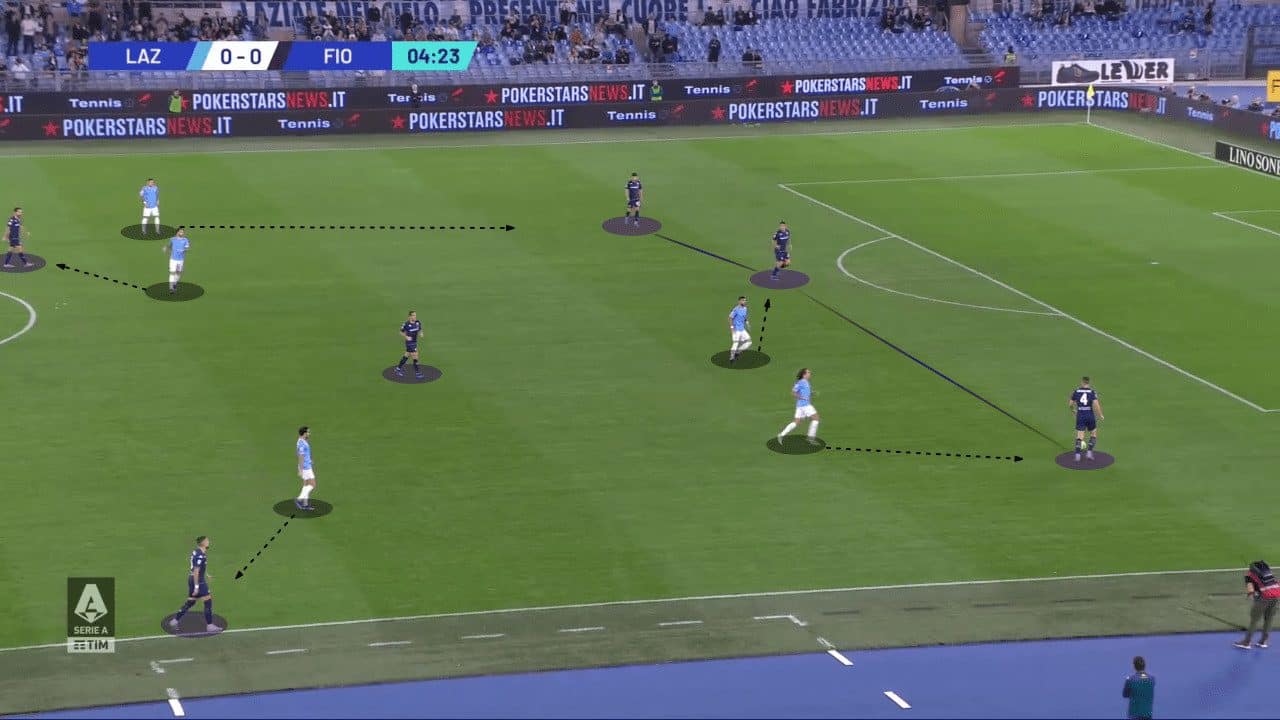
The shadowed player here, Bonaventure, is positioned more on the right side instead of being centrally as he was against Napoli with the intention to move behind Lazio’s Zaccagni to delay him from pressing Parisi.
Martínez is passing to Parisi and makes his usual movement towards the midfield.
Arthur’s role was essential as he constantly moved in the opposite direction of the next pass.
Here, Arthur is moving towards the right side as Parisi will receive and play to his goalkeeper, who will switch the play to the left-hand side.
The Brazillian midfielder’s here is dragging Guendouzi away from Milenković.
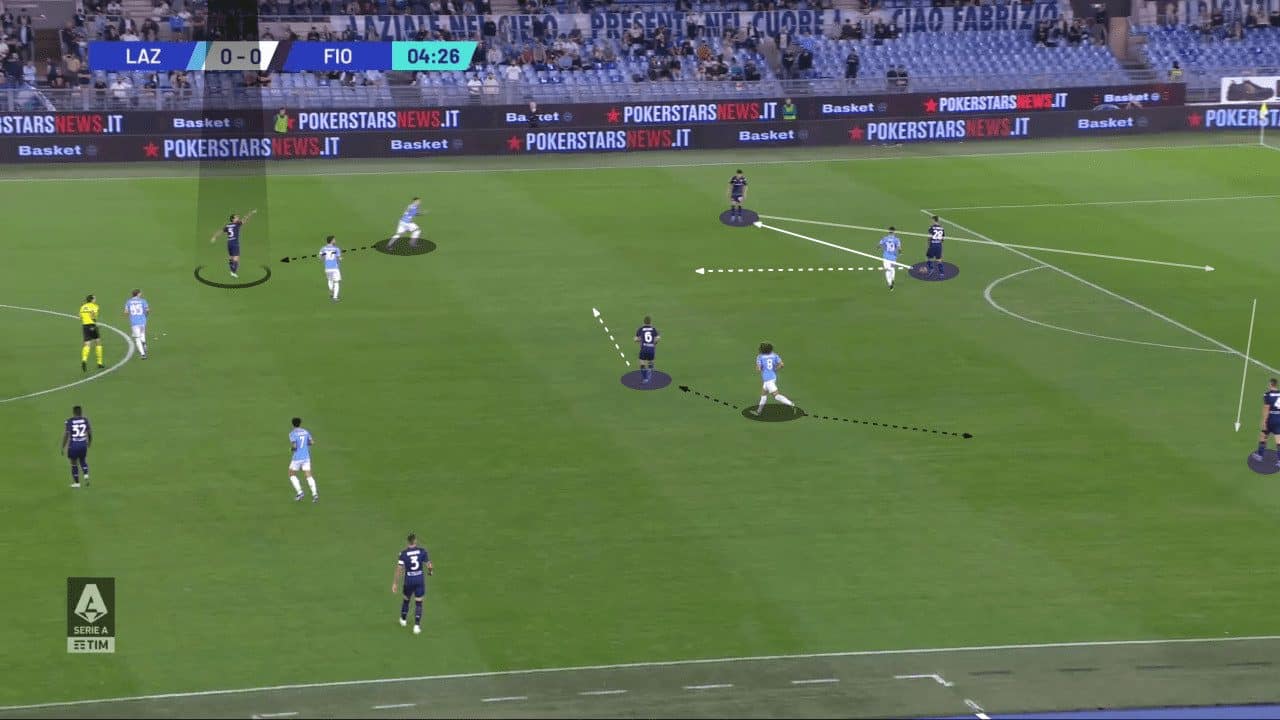
Thanks to Arthur’s movement, I received it without pressure as Guendouzi was late to press him.
Now Arthur (shadowed), is moving towards the left side to drag Castellanos with him, allowing the ball to be switched back to the right side.
Observe how Martínez, highlighted in white, is now positioned almost as the second pivot with Arthur and moving back to his normal position to be ready to have the ball again.
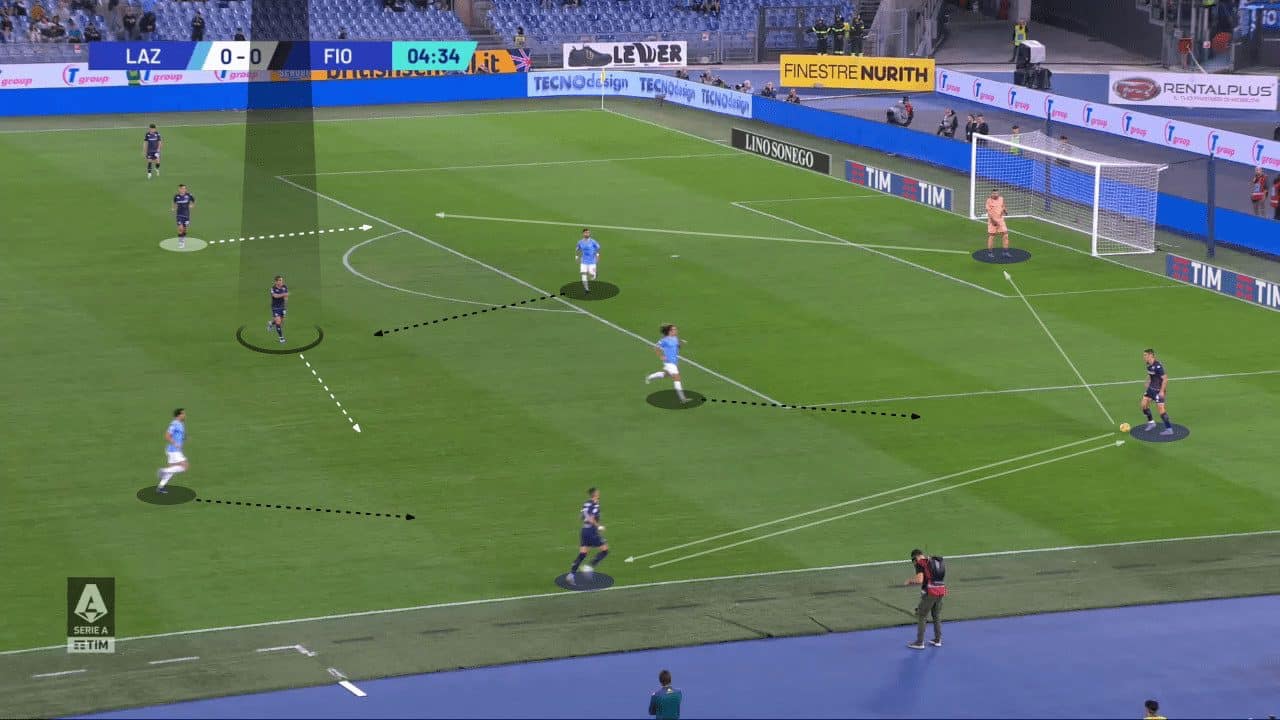
Arthur Successfully dragged Castellanos, and now the ball can be switched to the other side.
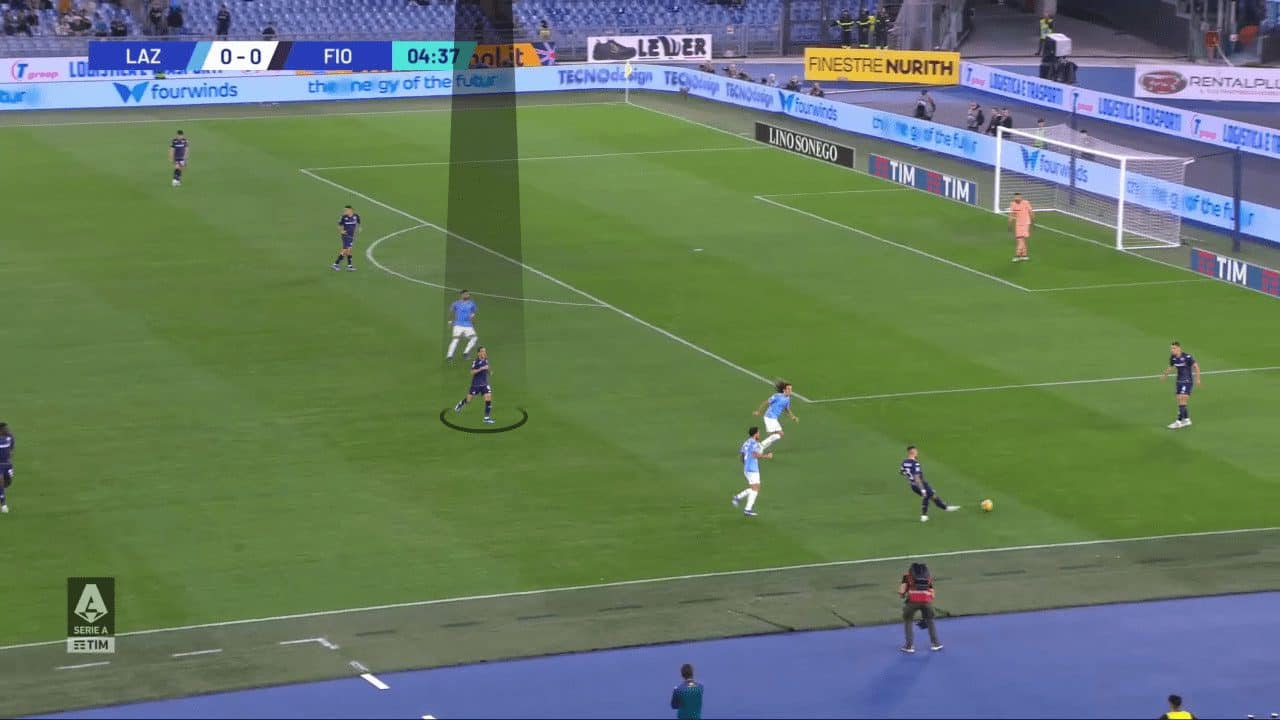
The ball moved to the other side towards Parisi, and Bonaventura was free thanks to his intelligent movement behind Alberto and the switching of play from his side.
Fiorentina’s striker Lucas BeFiorentina’soné (highlighted in white) are again pinning the back line, so no one steps to press Bonaventura.
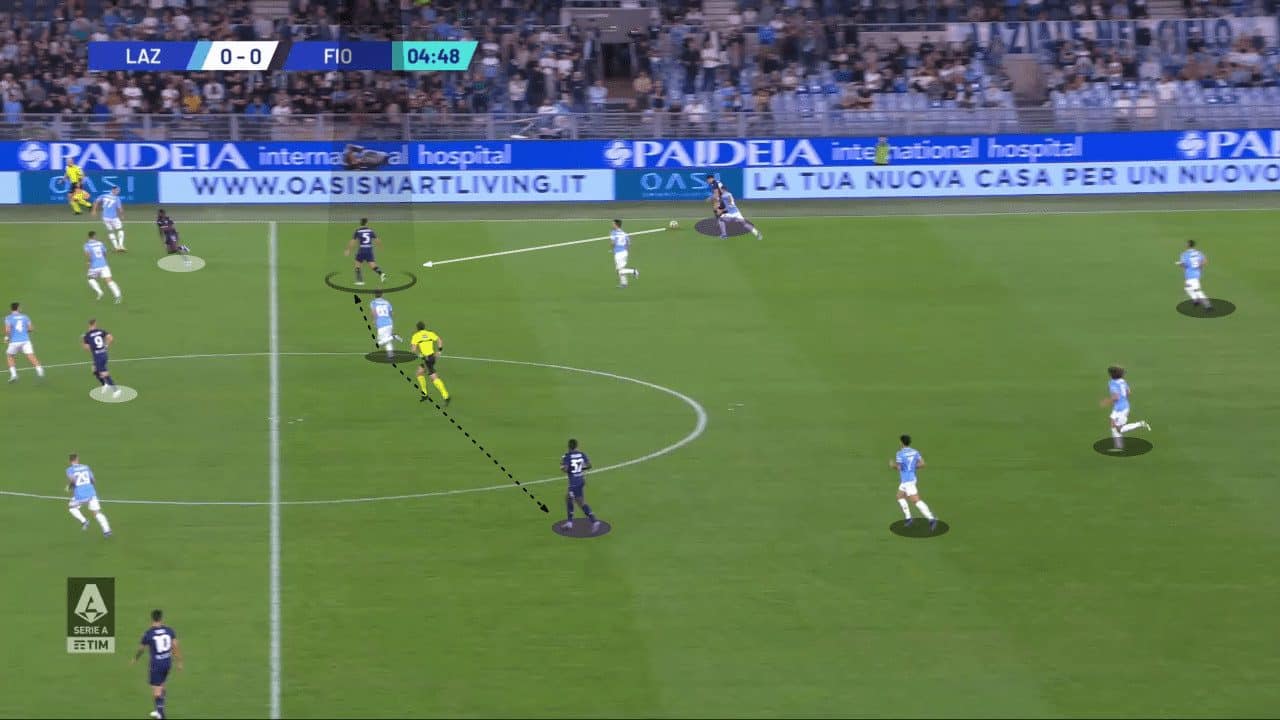
The ball was twice on each side of La Viola during the situation we discussed.
On another occasion, Duncan (shadowed) here dropped to pin Guendouza (shadowed), so the last couldn’t press Milenković, whicouldn’tr was preventing Alberto from pressing Martínez.
Milenković pass to Martínez.
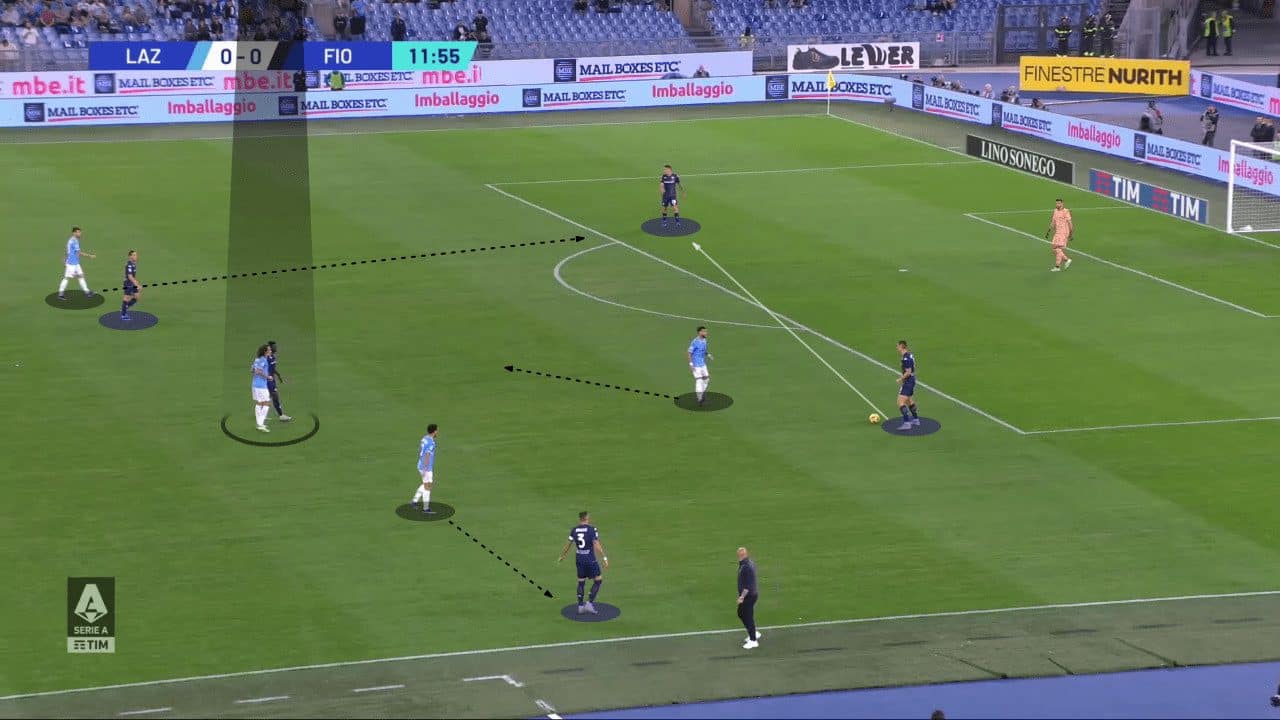
Martínez able to pass it back towards Milenković with no pressure as Arthur delayed Alberto.
Now Arthur is moving to the ball side so that Fiorentina can circulate the ball again.
Anderson (highlighted in white) is stepping to press Milenković as Lazio struggles to press the centre-backs, leaving Guendouzi to mark Biraghi.
Milenković passes to Biraghi.
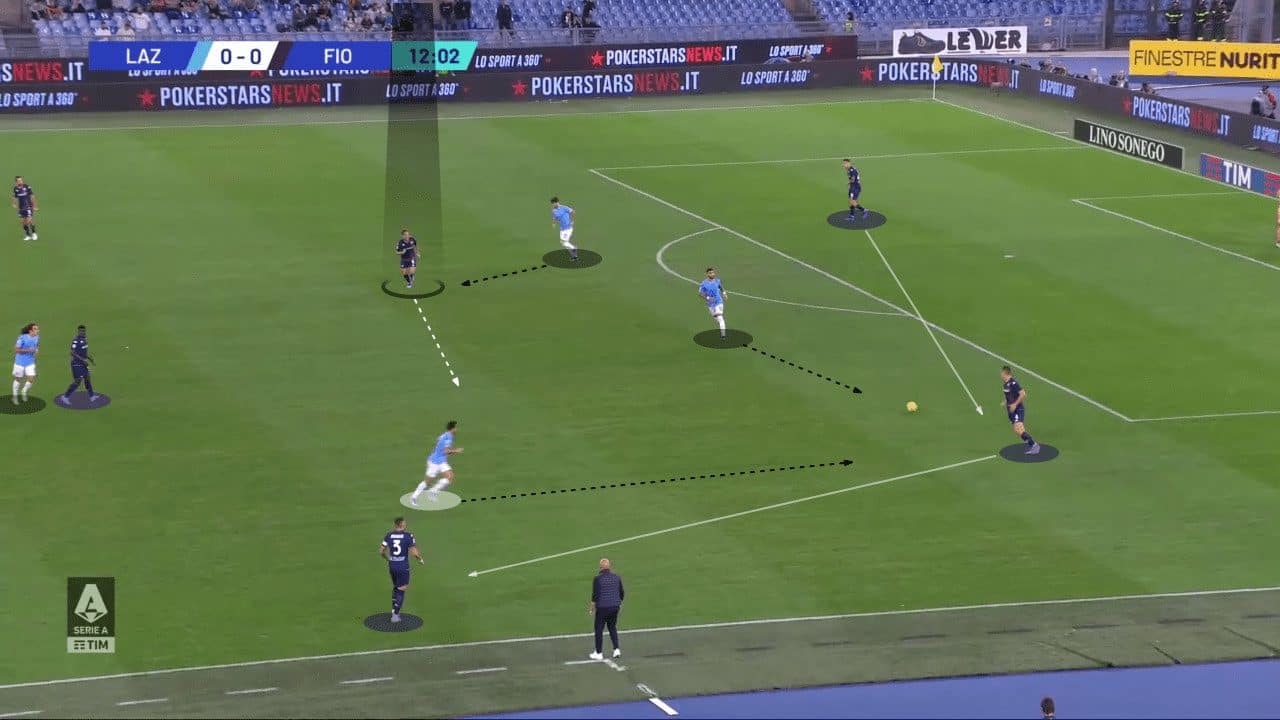
Milenković returns to Martínez with the same movement from Arthur, and again, Alberto is late to press Martínez.
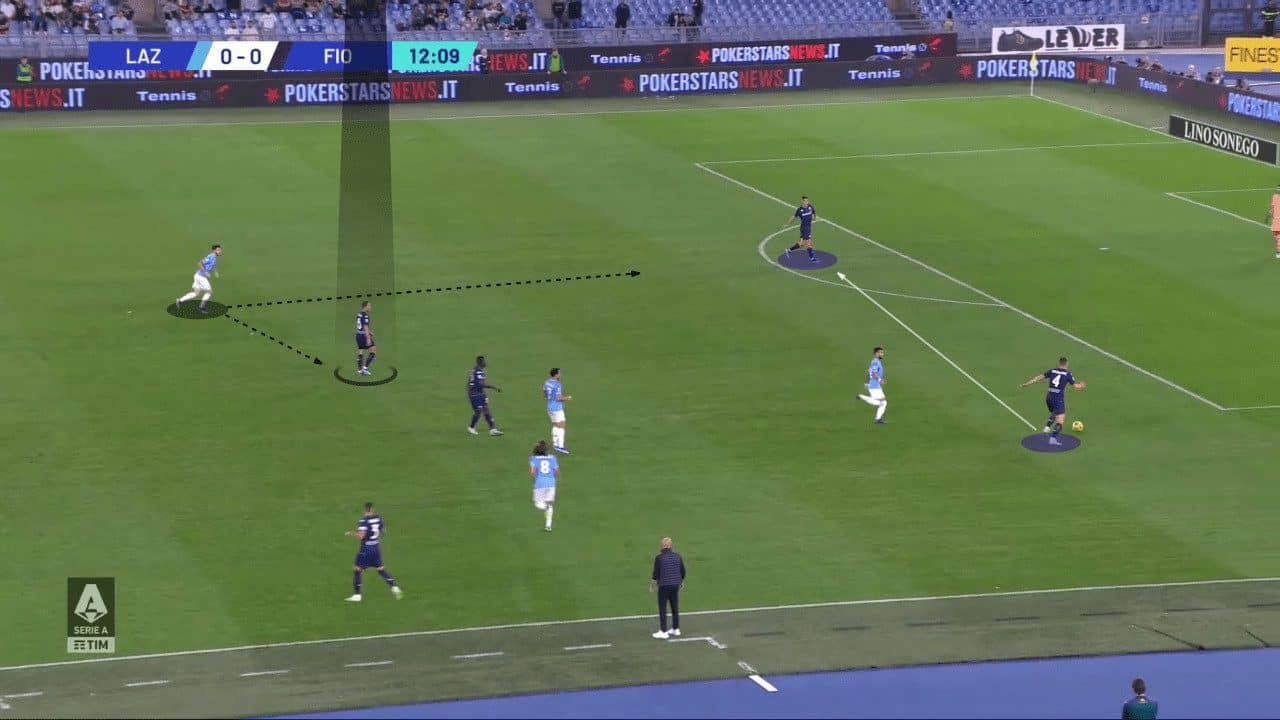
Martínez switches the play towards Parisi and notices how Arthur is pointing for Martínez for the pass and moves towards the ball side to drag Alberto again so they can circulate the ball.
Bonaventura’s positioning is Bonaventura’se to pin Nicolò Rovella so Parisi can receive with no pressure.
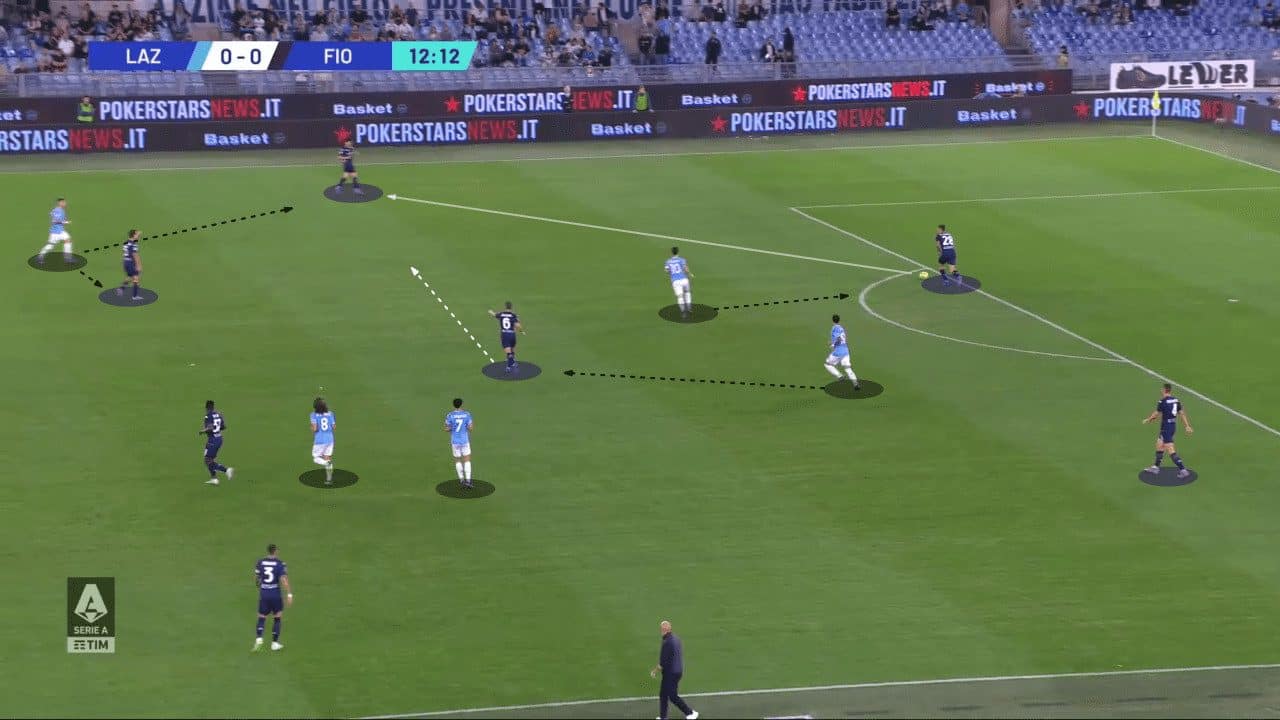
Parisi returned to Martínez as Arthur dragged both Alberto and Castellanos.
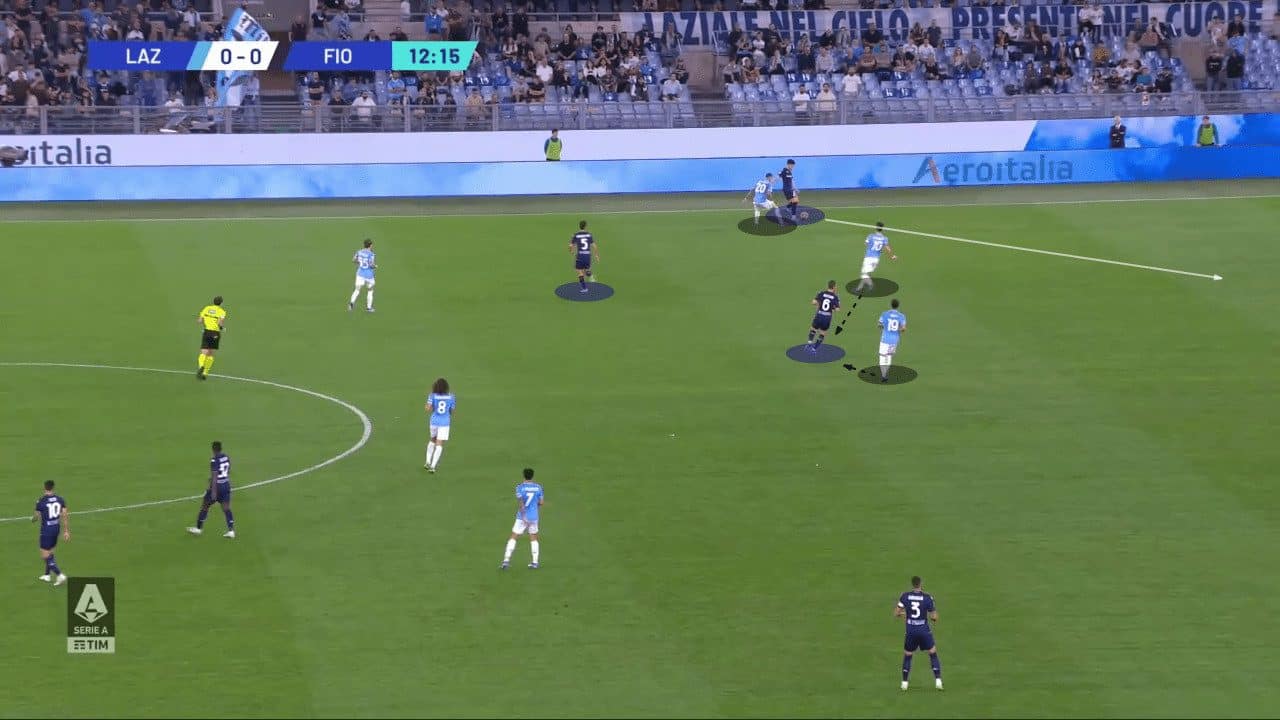
Martínez found Milenković in aches of space ahead of him, and they were out of pressure.
Count how many times the ball got on each side during the same build-up.
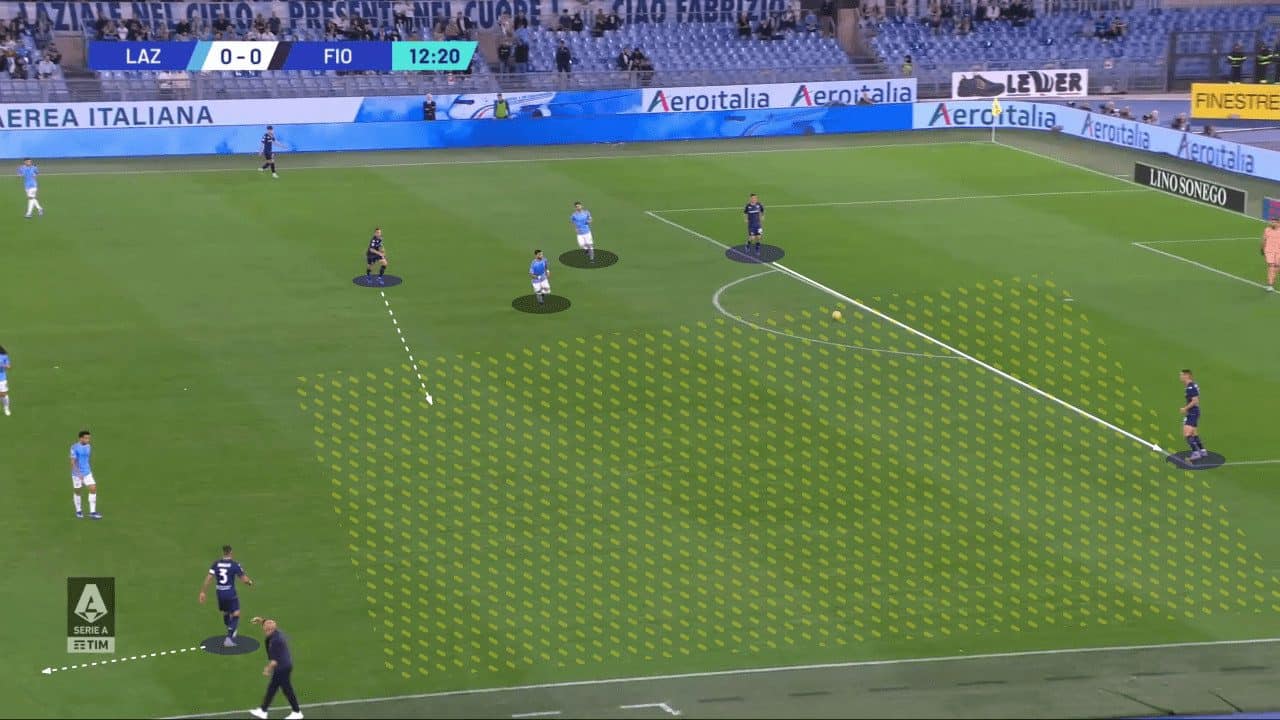
Typically, we can notice the same scheme with Arthur and Bonaventura’s movements, as well as Beltrán and Ikoné (highlighted in white) pinning the backline.
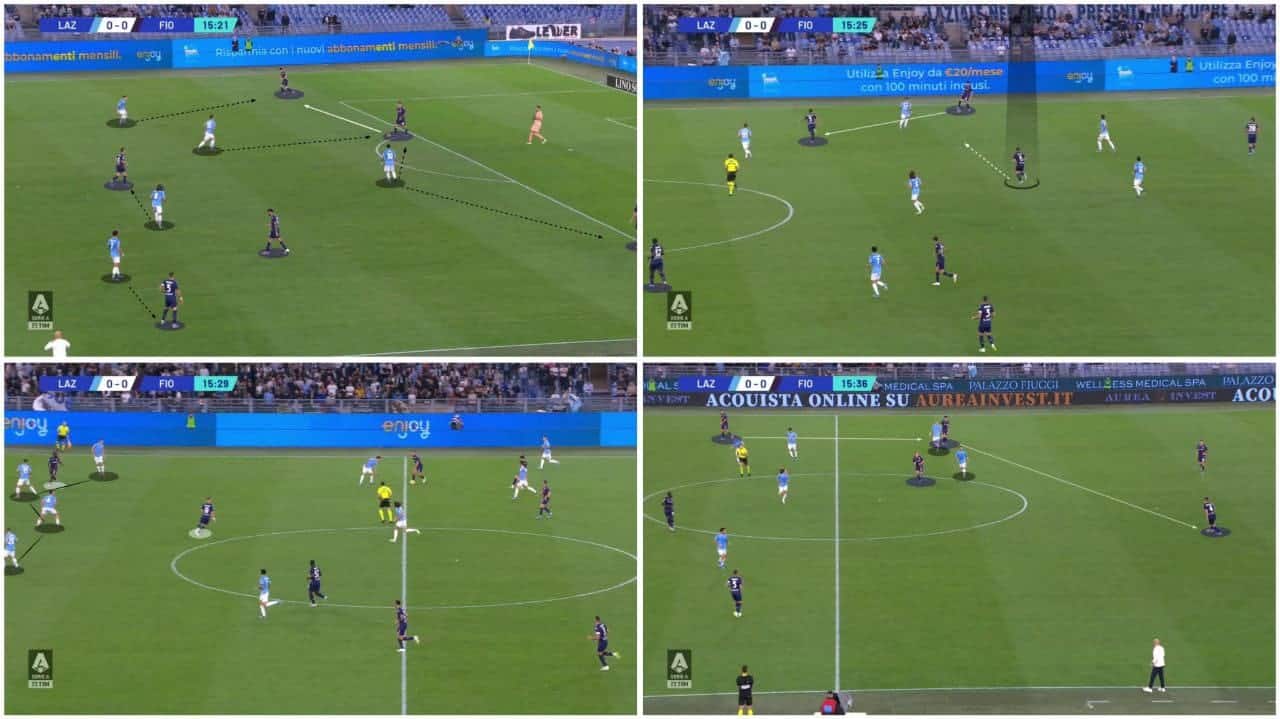
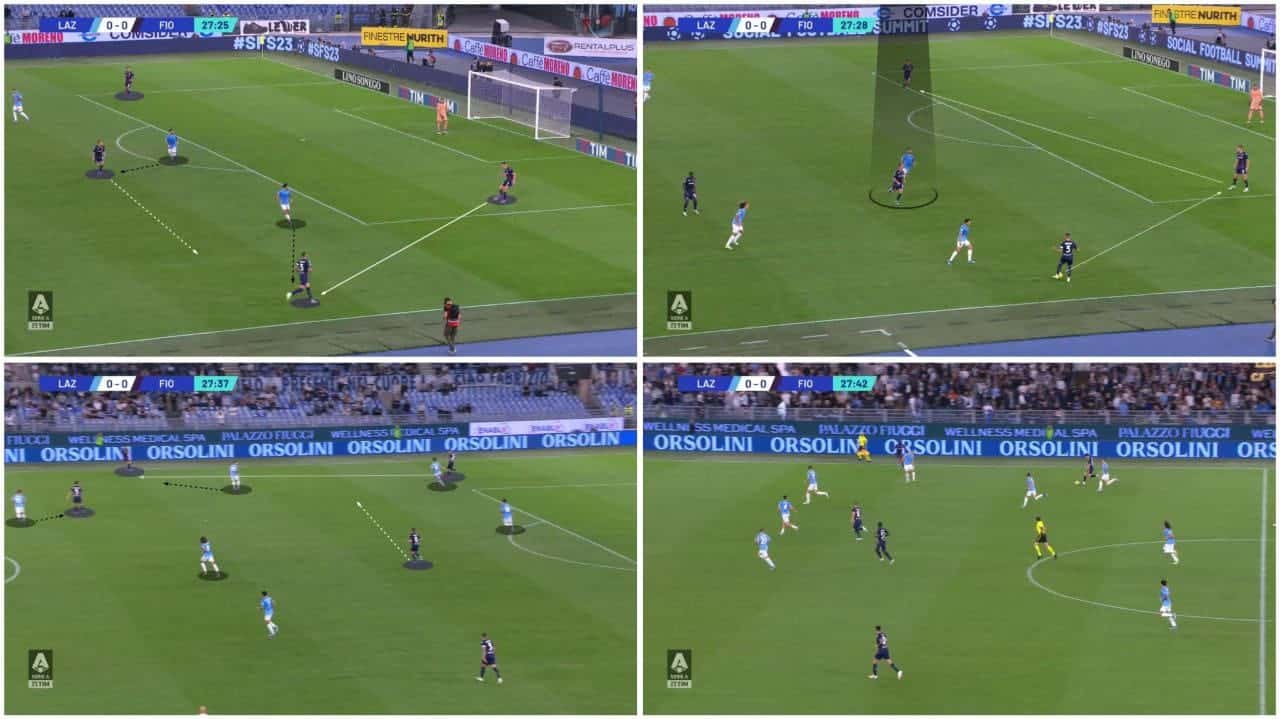
That flexible switching of play gave them the advantage of having an overloaded side.
Here, Bonaventura succeeded in switching the play towards Milenković, who carried the ball to have a 3v2 numerical advantage on the left side.
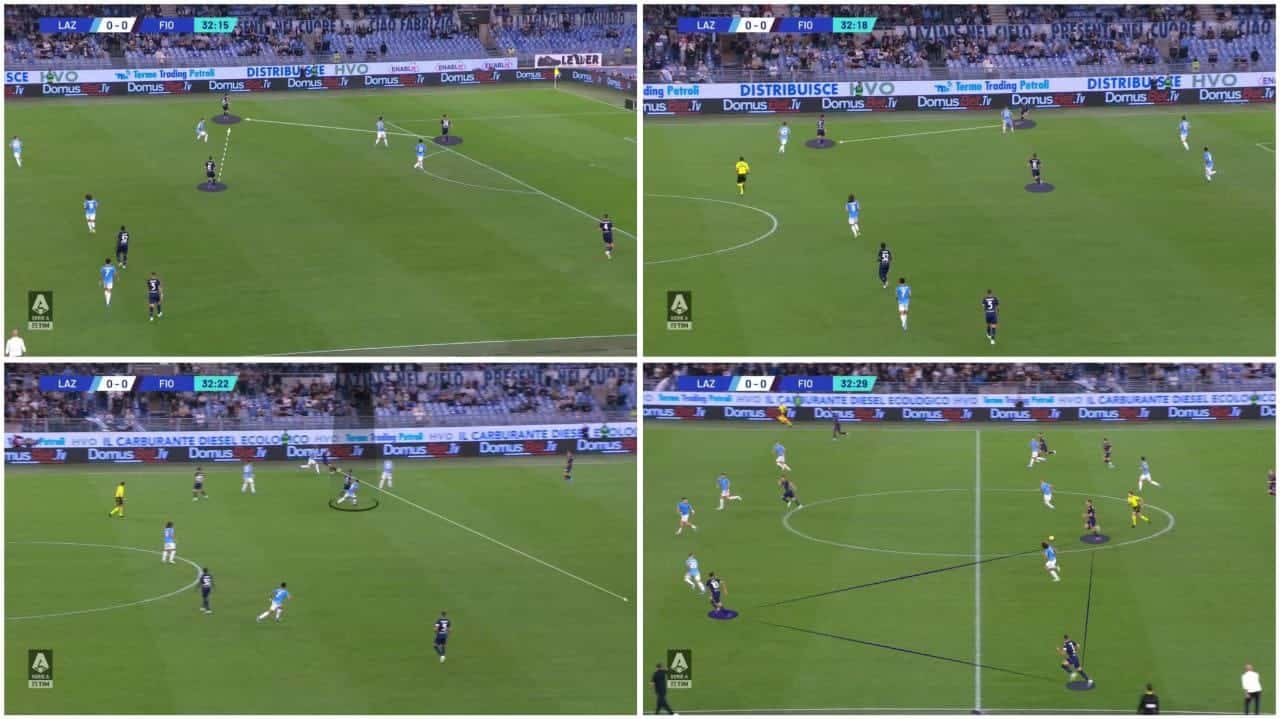
Another approach shown by Italiano’s side is to use Italiano’s side is building via combinations through Gonzalez and Duncan.
The shape of a back three with Milenković pushes forward, and Terracciano plays a direct long ball towards Gonzalez.
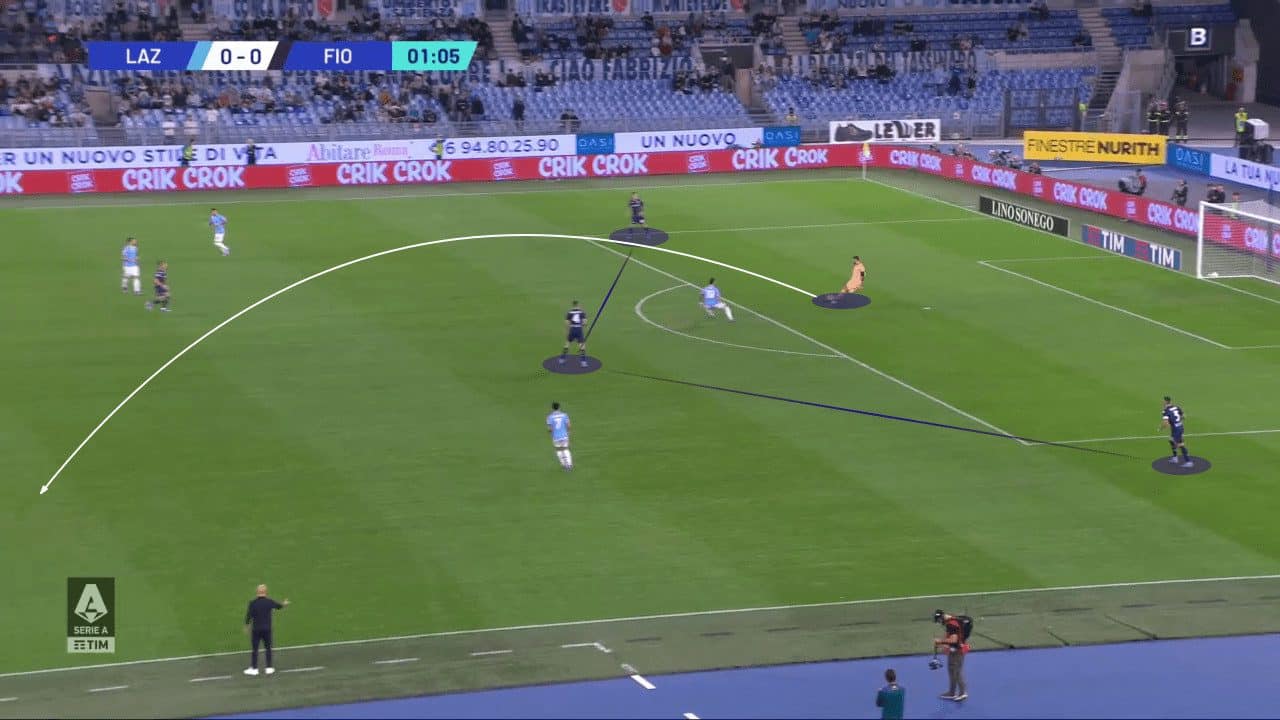
Here, Duncan (shadowed) is moving, dragging Guendouzi with him and making Manuel Lazzari hesitate to press Gonzalez.
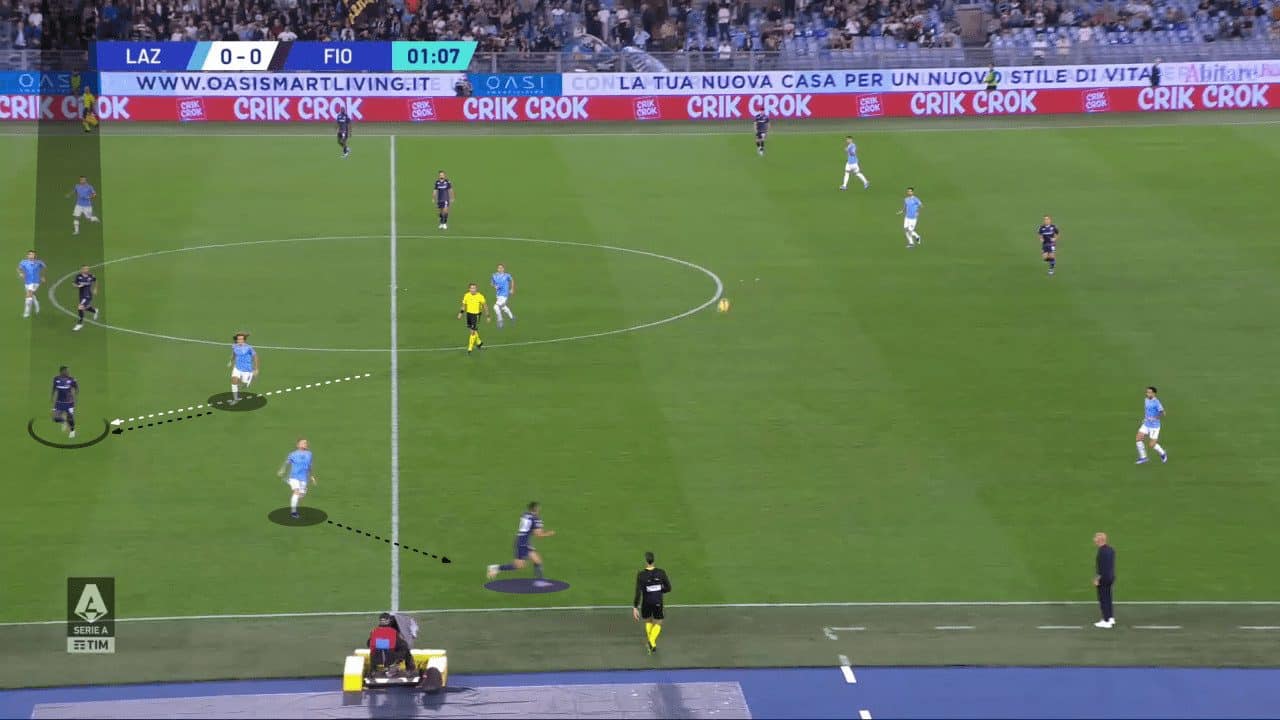
Furthermore, a back three and this time Martínez is joining Arthur in the midfield, Terracciano plays to Biraghi.
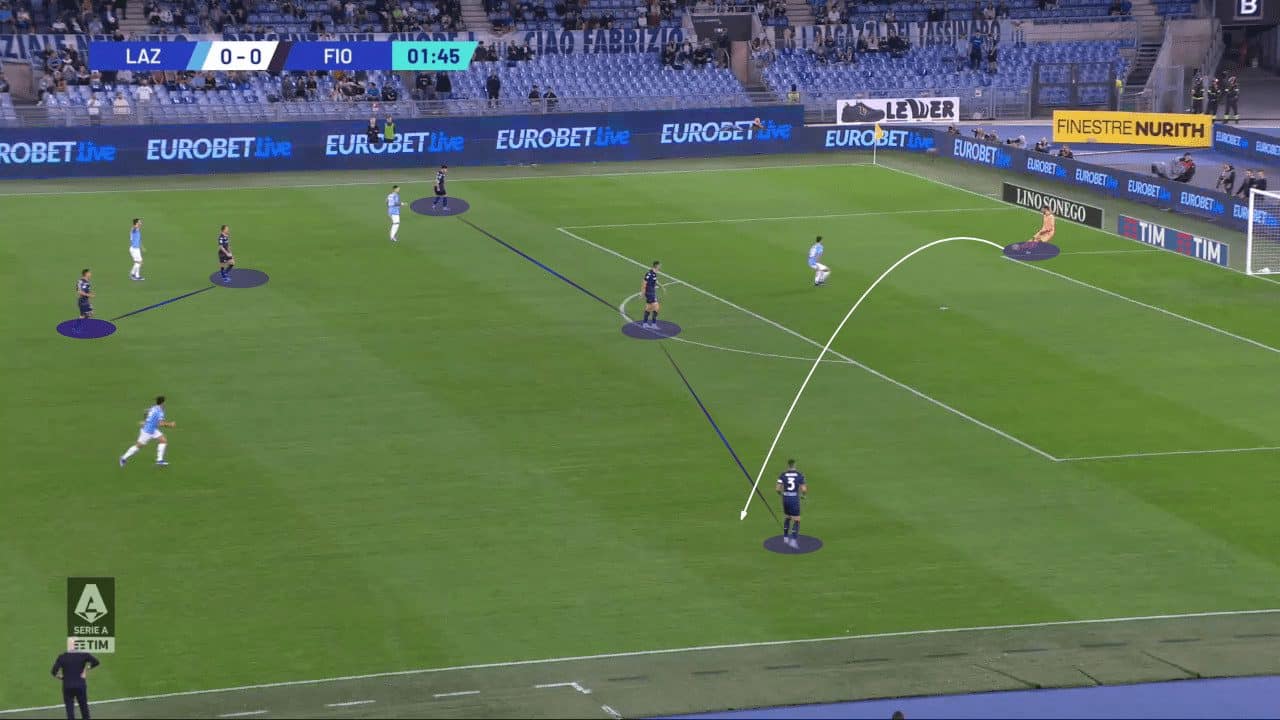
Biraghi passes down the line to Gonzalez.
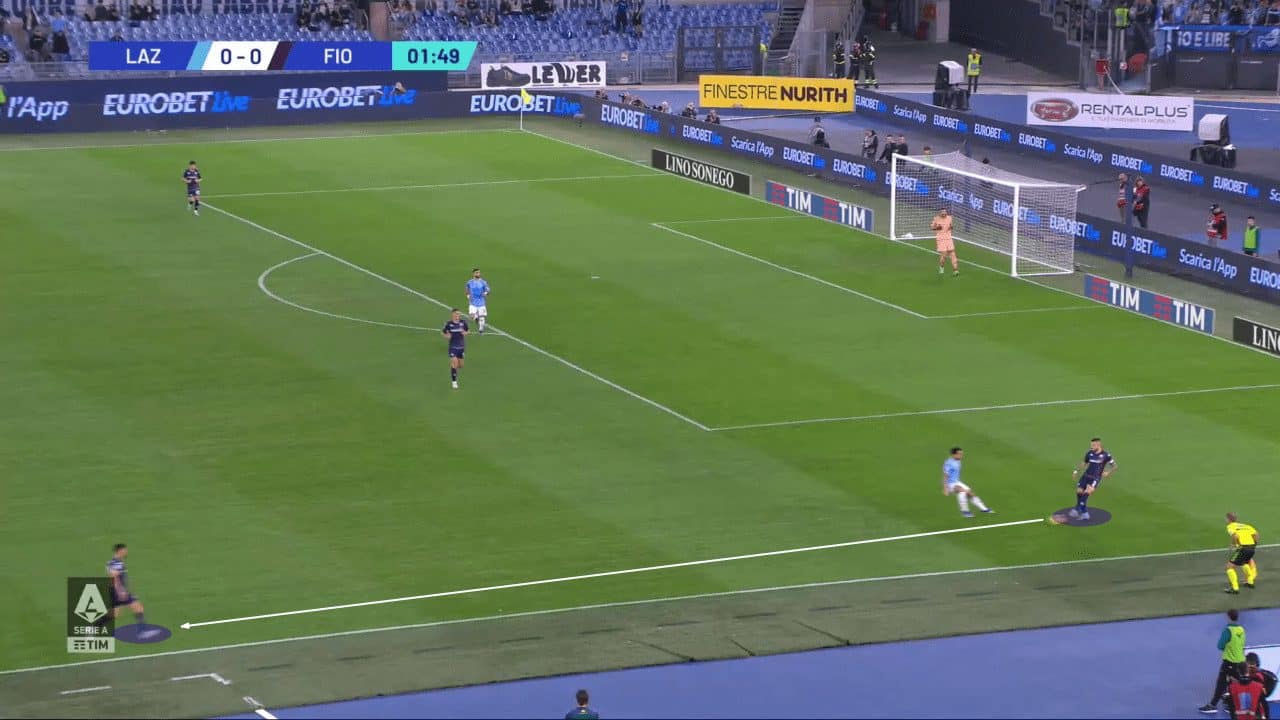
Gonzalez found Duncan running behind Lazzari again.
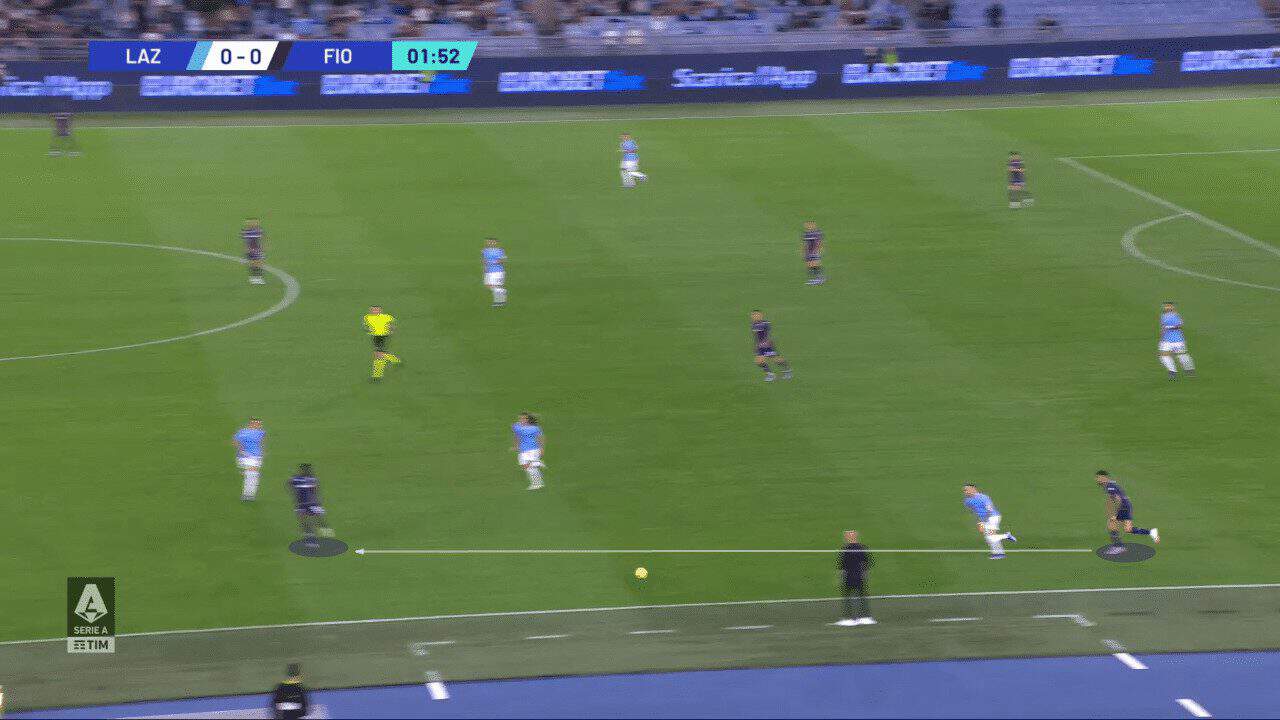
Martínez plays a long ball towards Gonzalez while Duncan makes the same movement.
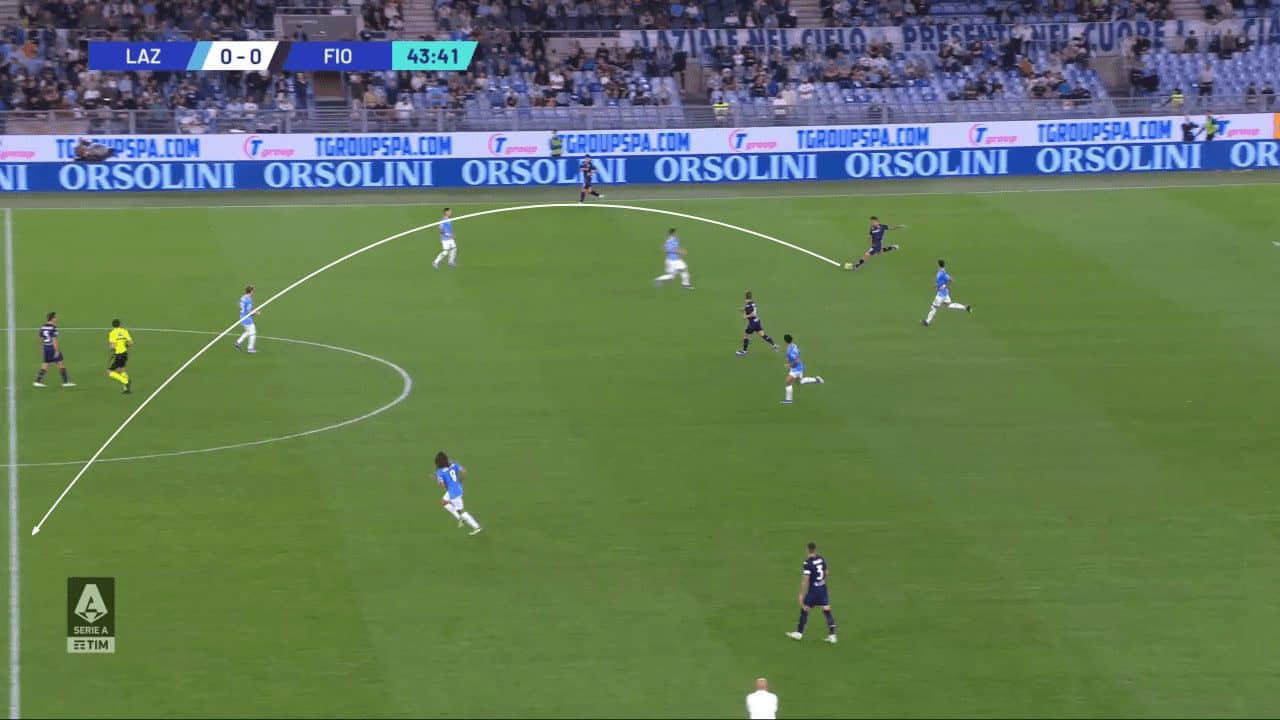
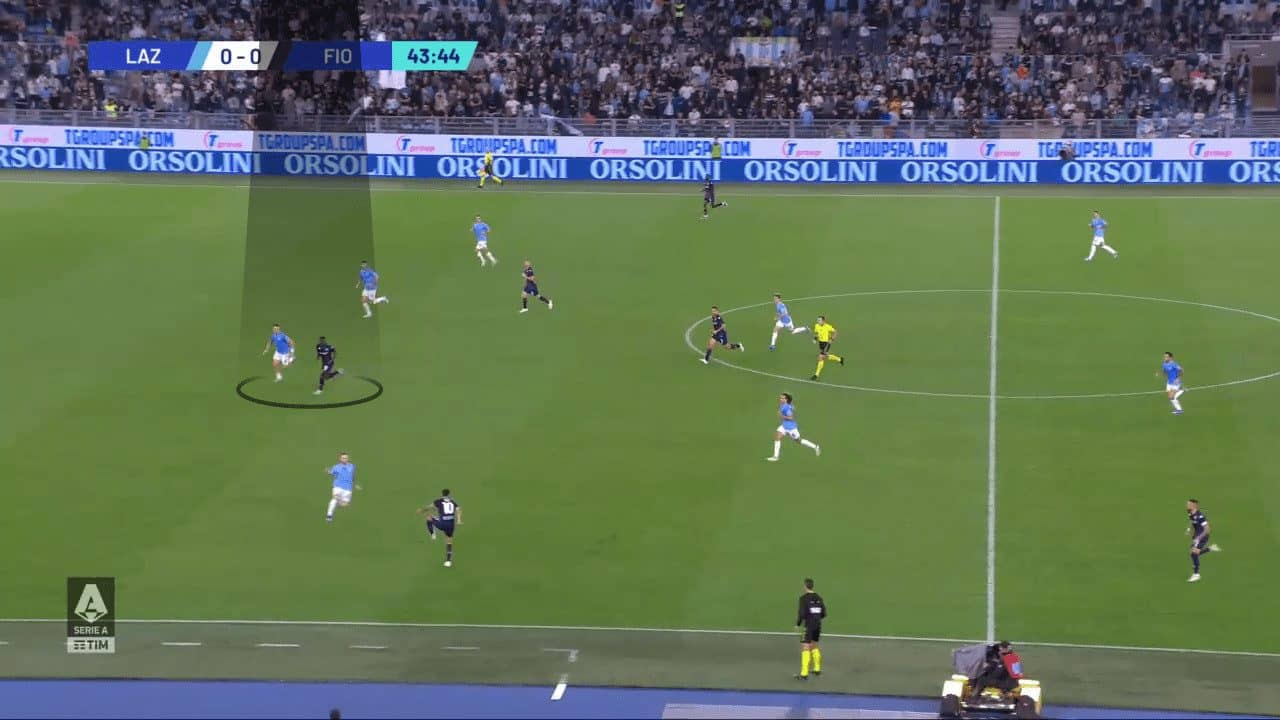
During Progression
One of the shapes they had during progression was 4-2, with widely advanced full-backs increasing the distance between them and the centre-backs, so it’s harder to press them.
Asit’sl as, one full-back could be widely positioned while the other is narrow or inverted, leaving the winger to provide the width.
Below, we can see how the right-winger Ikoné (shadowed) is overloading the midfield, and Kayode is wide.
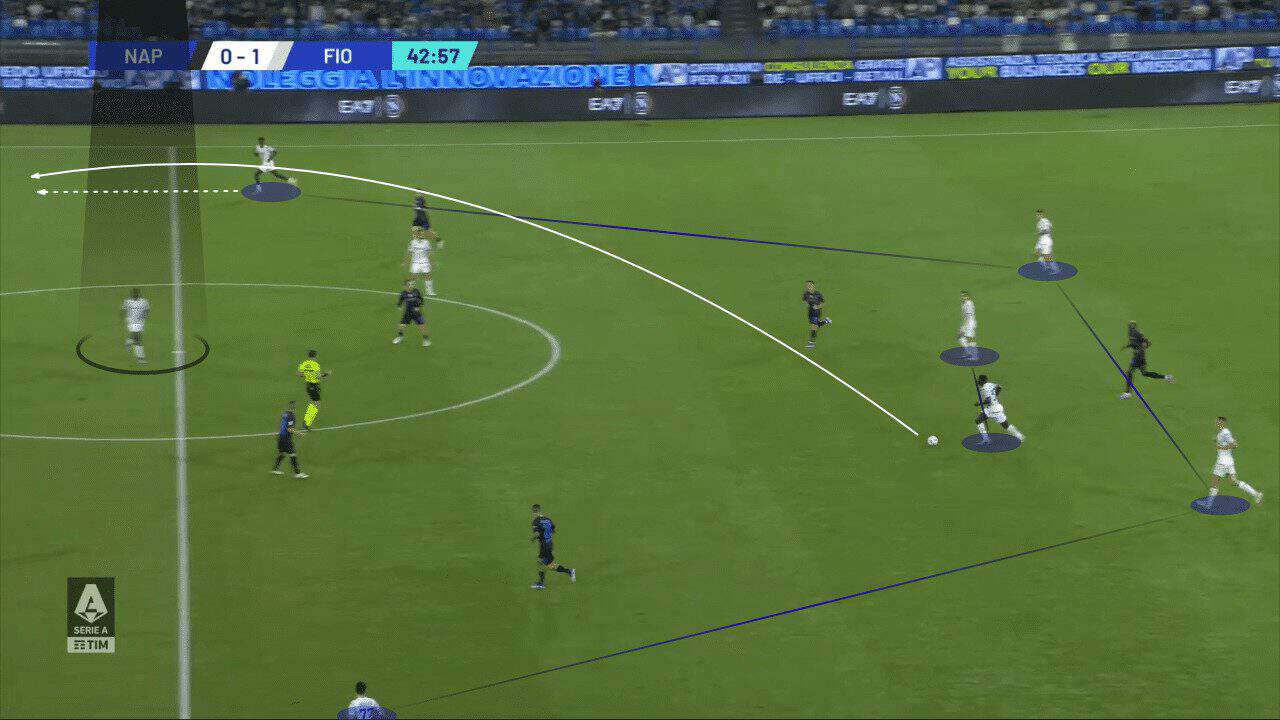
Additionally, they have a diamond shape similar to the one we mentioned in the build-up, with two inverted full-backs overloading the midfield with Arthur and Bonaventura.

Duncan can also drop on the first line to create numerical superiority and a back-three line.
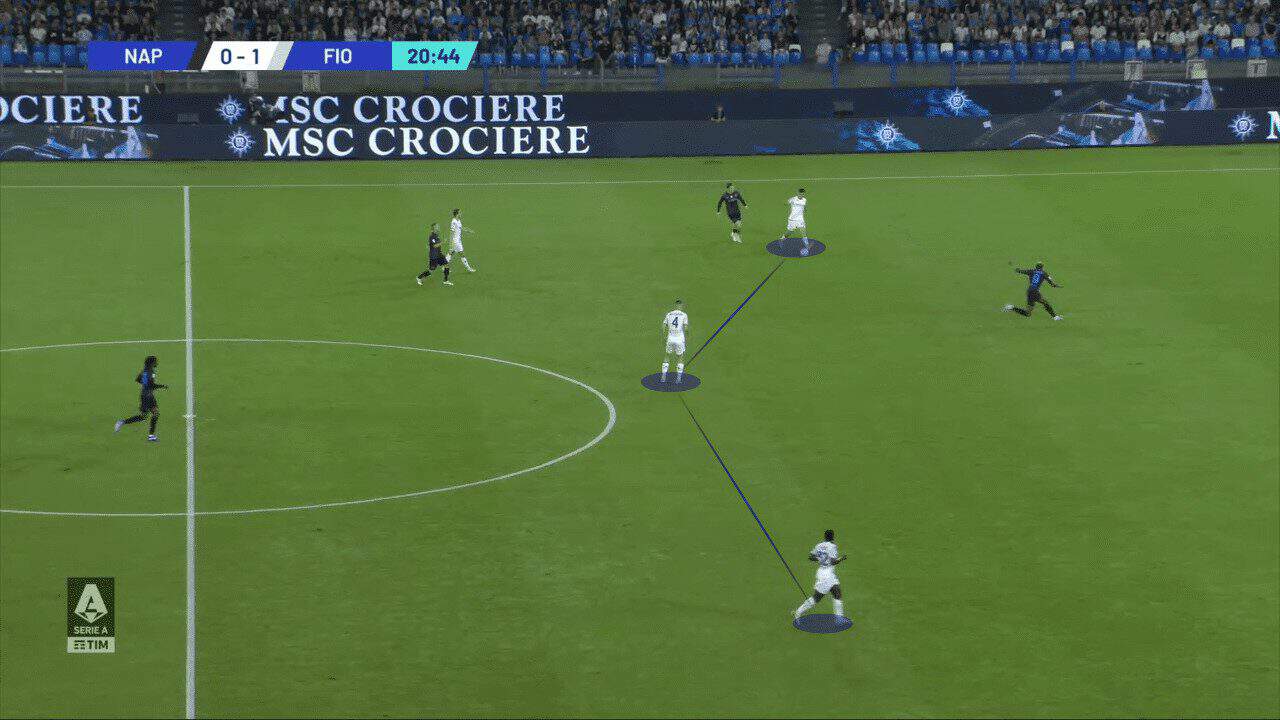
Duncan’s position helped Fiorentina overcome Napoli’s first line of pressure.
They could find Bonaventura, who is on the same line as Arthur and Parisi (the inverted left back), overloading the midfield.
Meanwhile, Ikoné and Nzola (highlighted in white) are occupying the opposition’s centre-backs to the opposition’s advantage in the midfield.
Also, on the right, Kayode (shadowed) is widely positioned.
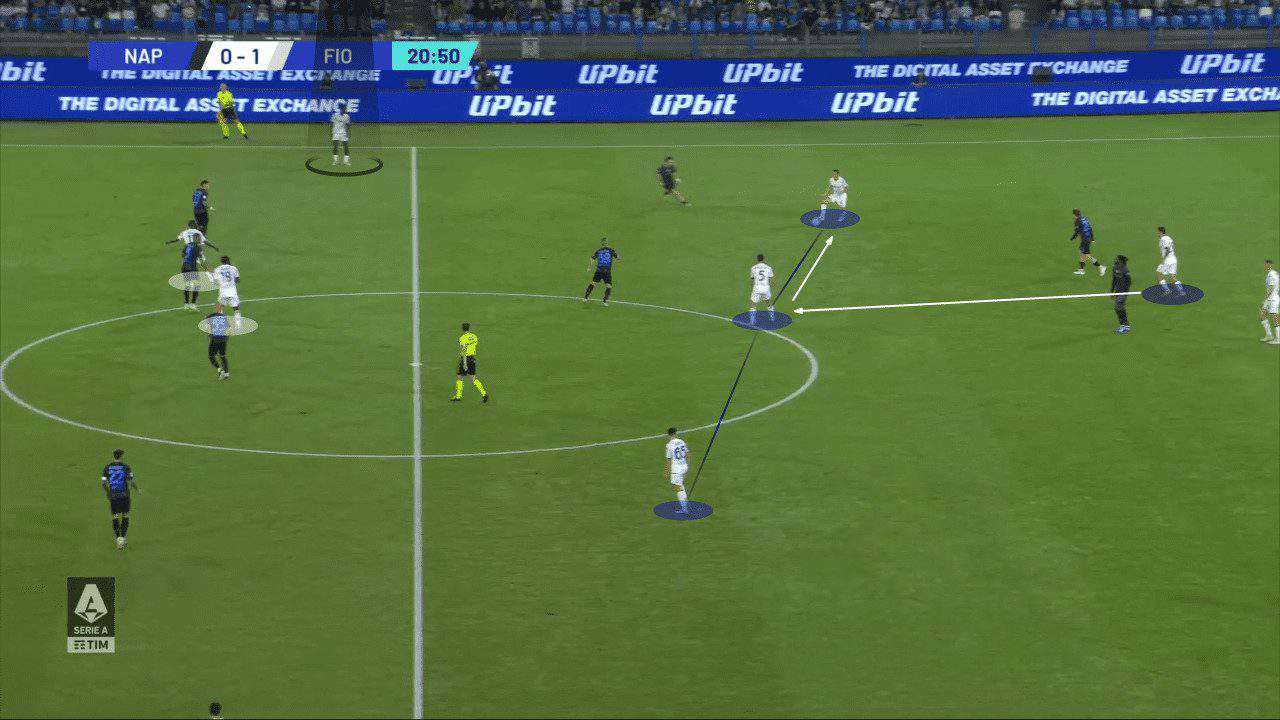
The same diamond shape as Duncan is dropping to form the back-three and the exact positioning as Kayode.
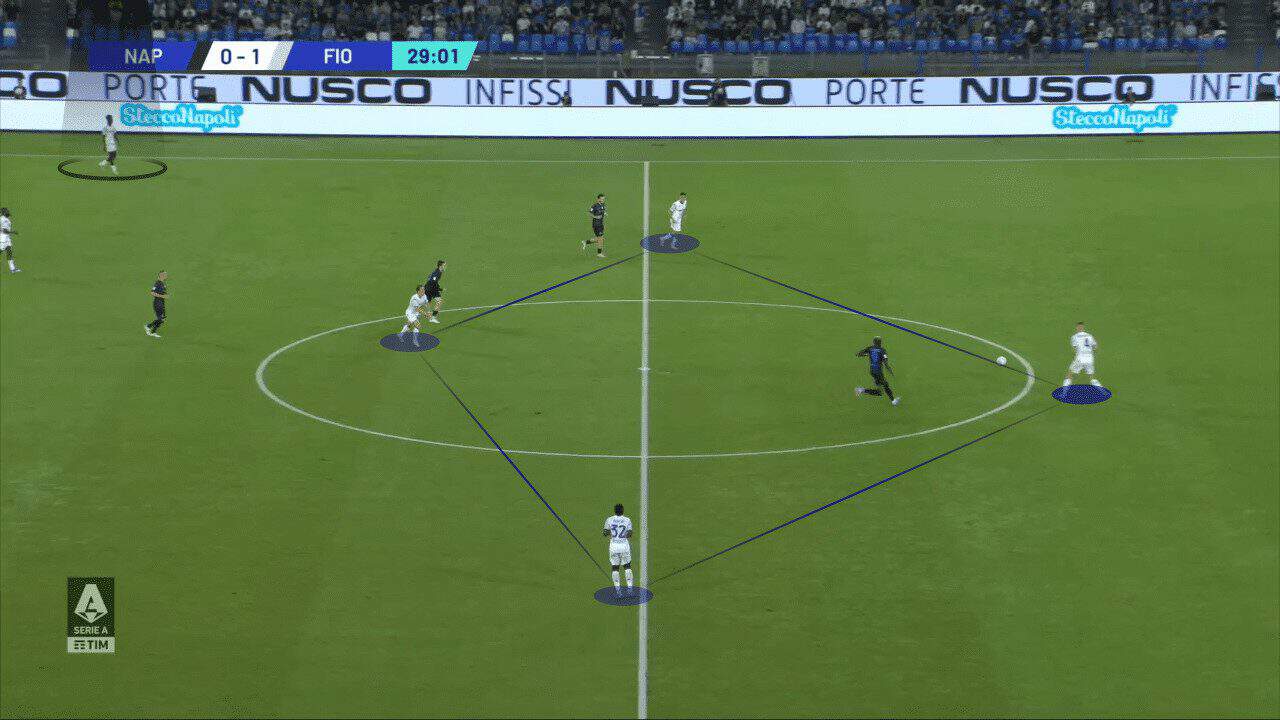
The away side showed great variation and flexibility.
The same back-three shape of Kayode, Milenković and Duncan, with Martínez (shadowed) joining the midfield with Arthur.
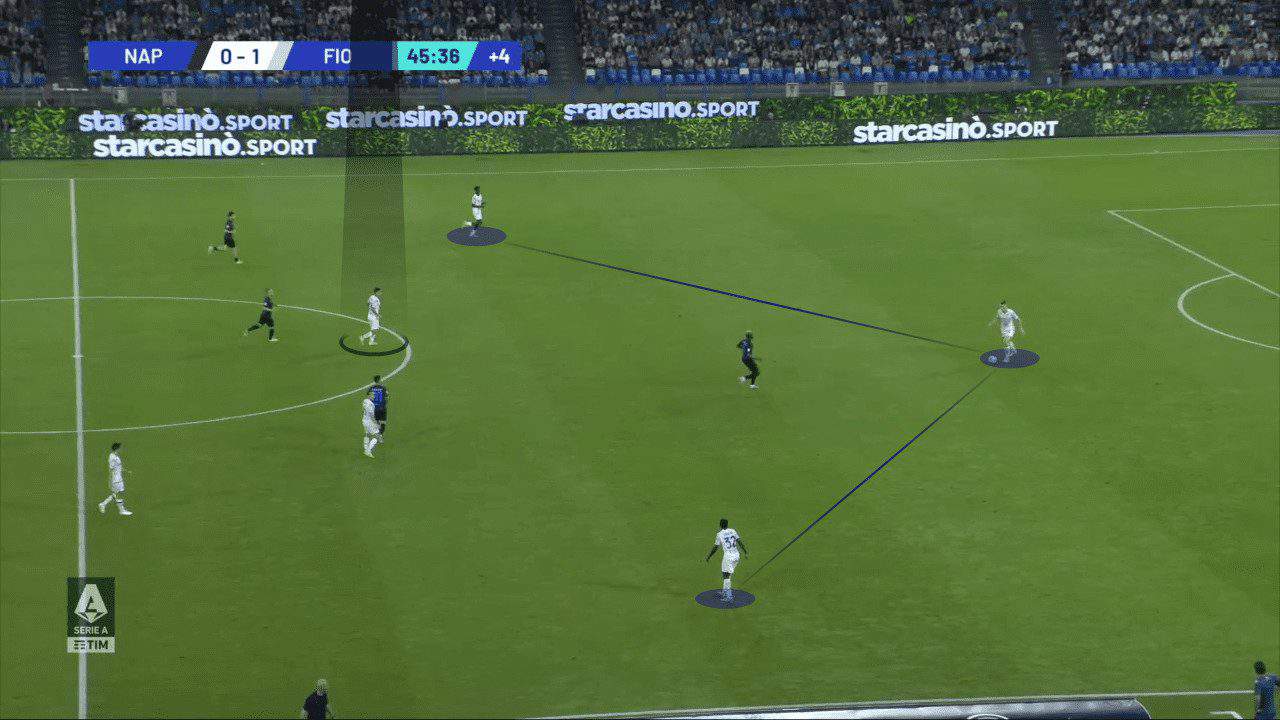
Martínez has made a significant contribution during all the offensive phases with his attacking runs and advanced positioning.
Below, he is shadowed, overloading the midfield.
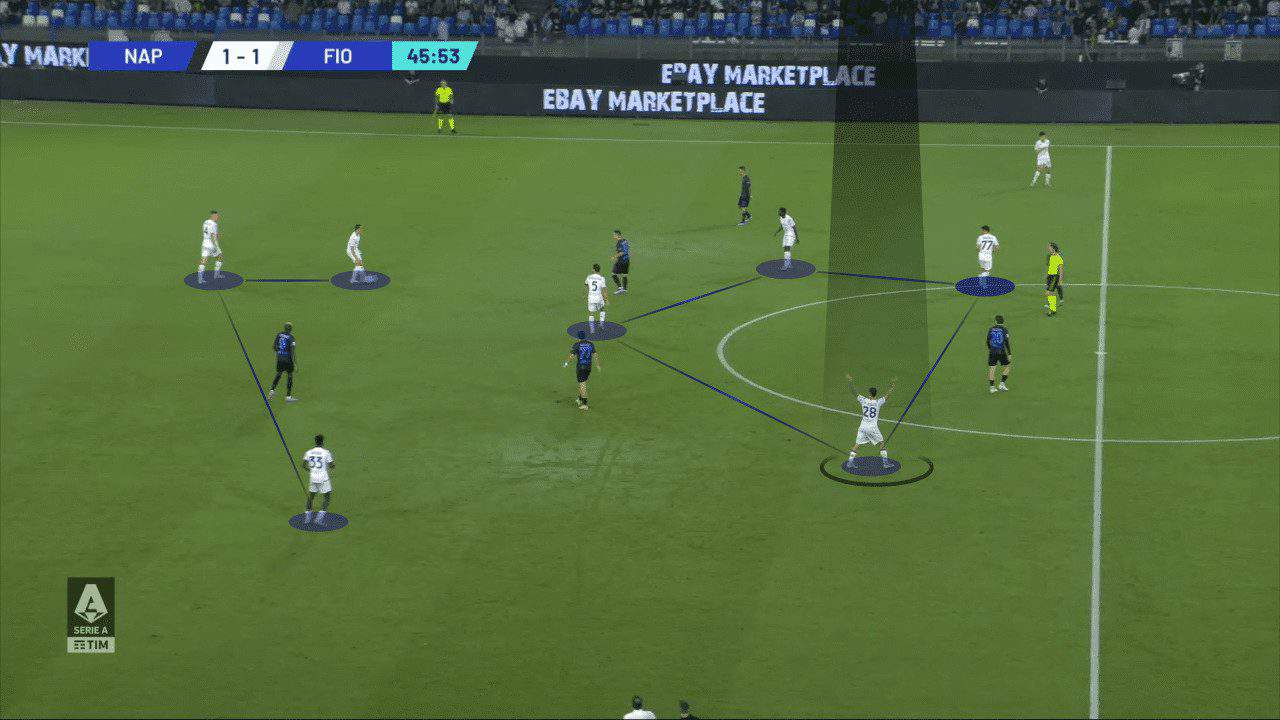
Not only is the Argentinian overloading the midfield, but they can also make progressive passes and join the last line,e and Parisi (highlighted in white) is now dropping at the backline to compensate for the attacking contribution of Martínez.
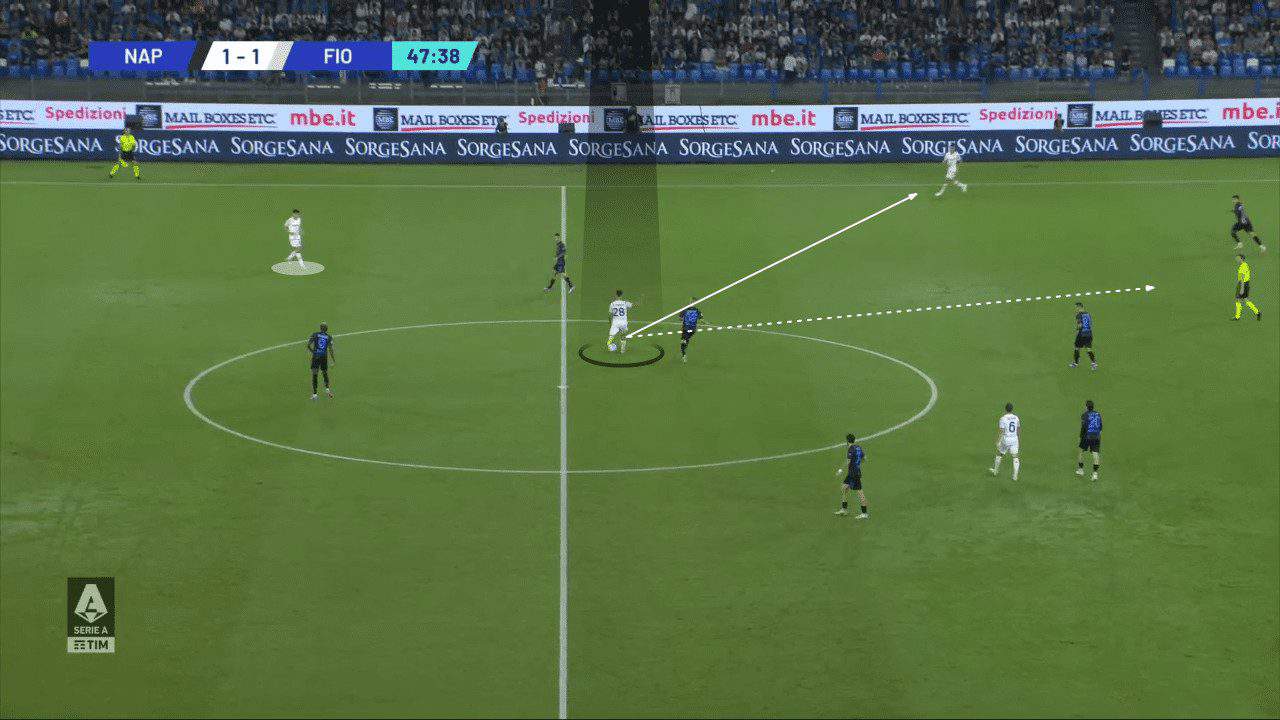
He notices the open space and makes the run, creating a good attacking situation for his team.
Arthur is aware and covering him.
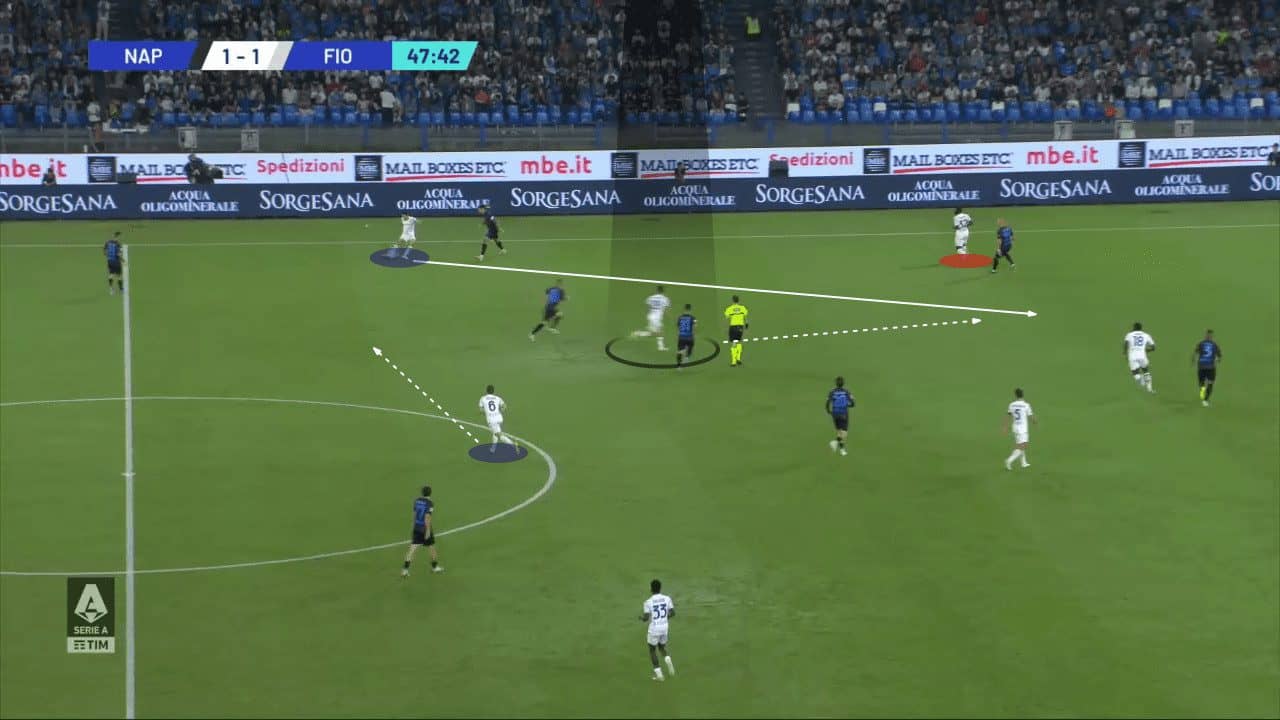
Against Lazio, they maintained the wide advanced position of their full-backs (highlighted in white).
Anderson was dragged to press Milenković due to the high distance between the centre-backs and full-backs, like Guendouzi, who stepped to press Gonzalez.
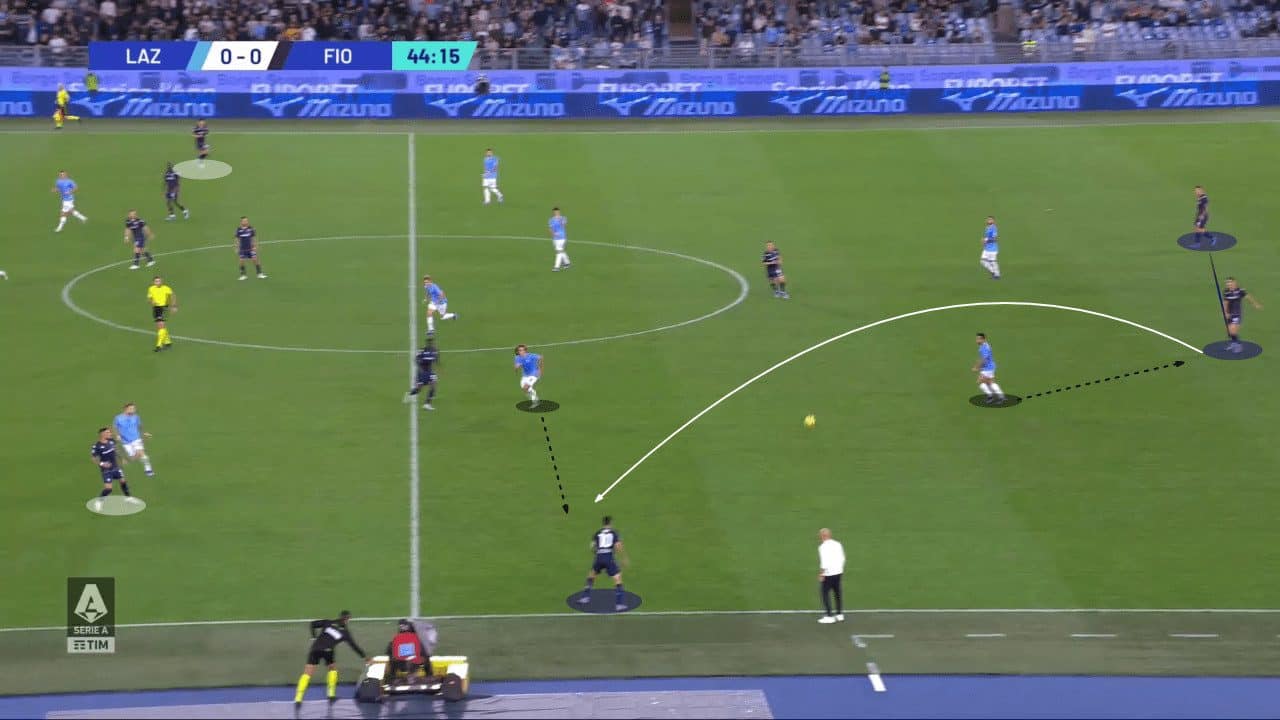
That got Rovella in a 2v1 against Bonaventura and Duncan.
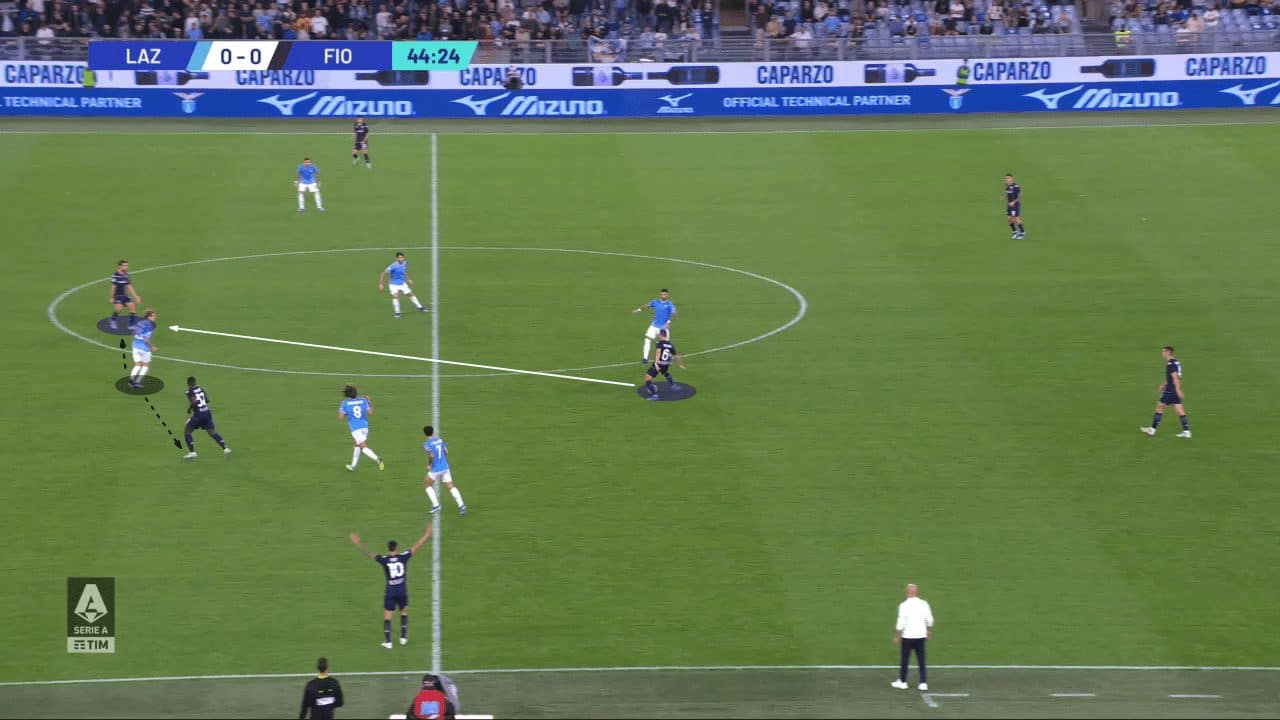
As well as forming a back-three with Arthur joining the backline to facilitate the progression.
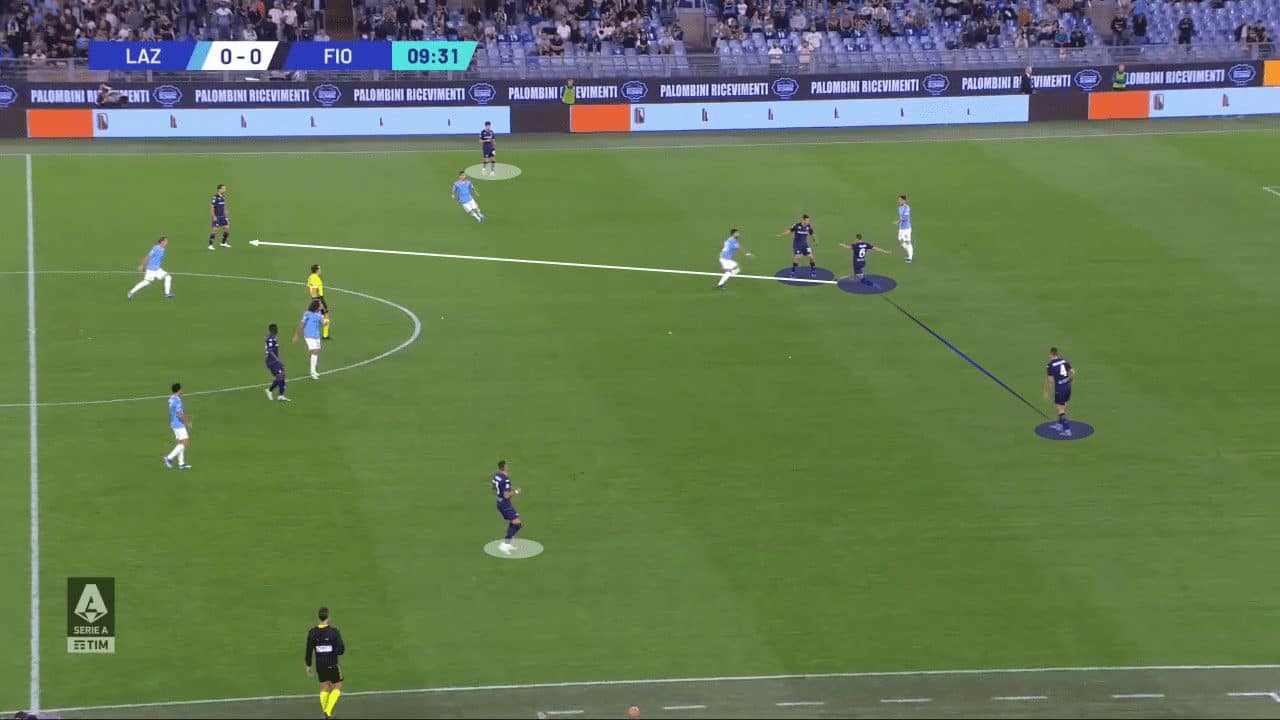
That distance between the centre-backs and full-backs we mentioned got the opposition in trouble; as shown below, Martínez is passing to Parisi.
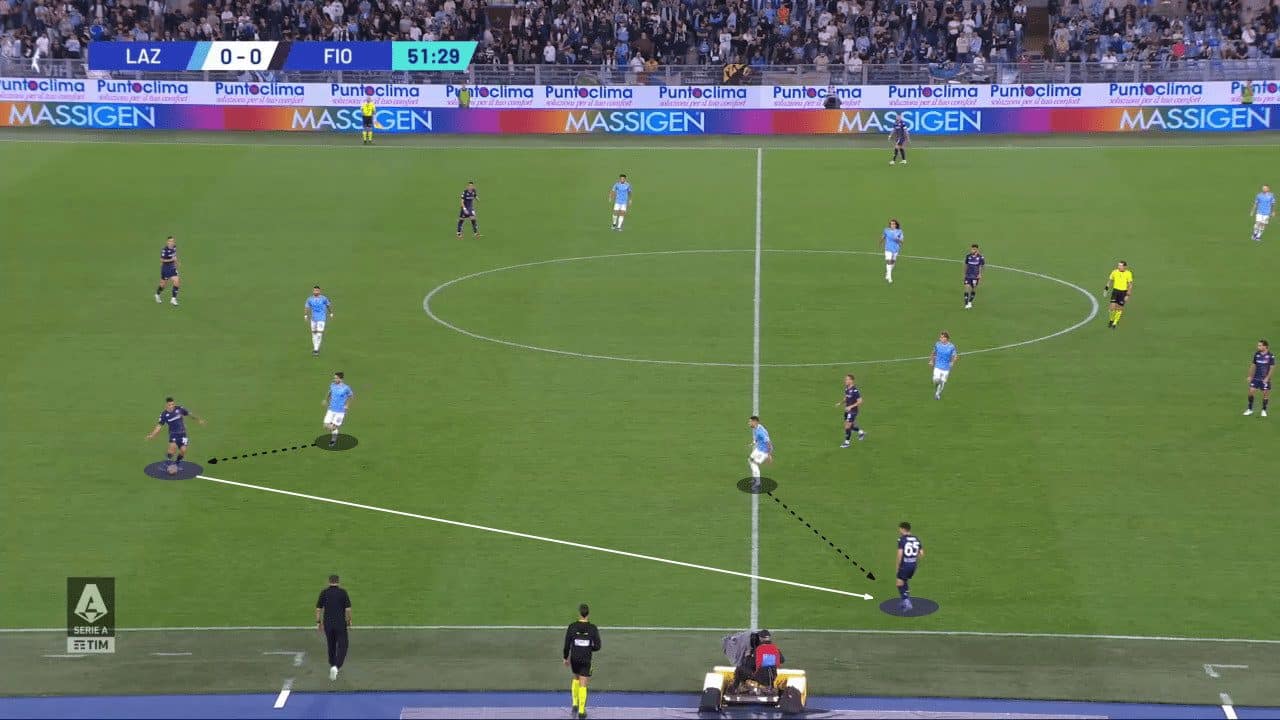
Lazio’s left-back Adam MarušiLazio’so jump on Parisi, leaving Ikoné to Alessio Romagnoli, which means a 2v2 situation is created against their centre-backs.
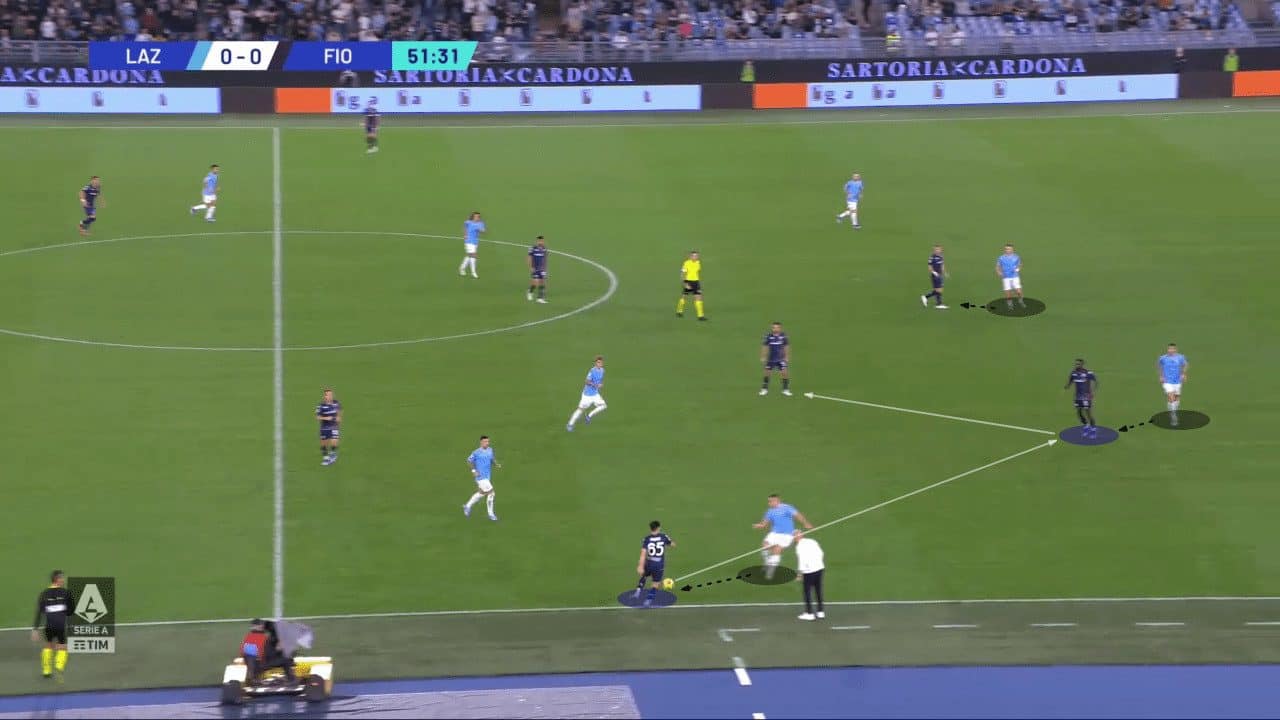
Notwithstanding, against Juventus, who had a mid-press shape of 5-3-2.
Fiorentina struggled during the game as they don’t have the same numerical advantage in the midfield due to Juve’s passive pressing, so it was easy to drag their midfielders in addition to their brilliant shuffling against the home side switching of play.
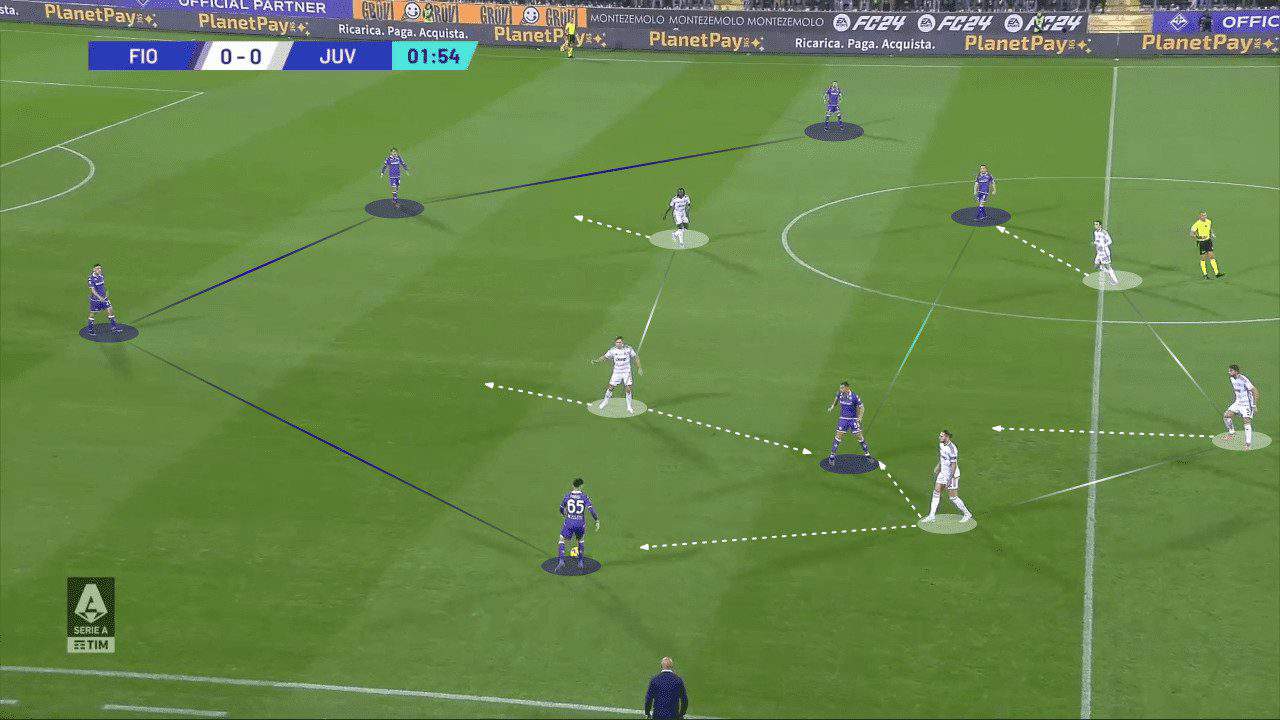
As Fiorentina switched the play from the right to the left side, trying to reach the isolated player “Biraghi”, the opposition’s right wing-back pressed him immediately.
Here, Juventus has Manuel Locatelli as an extra-man in the midfield.
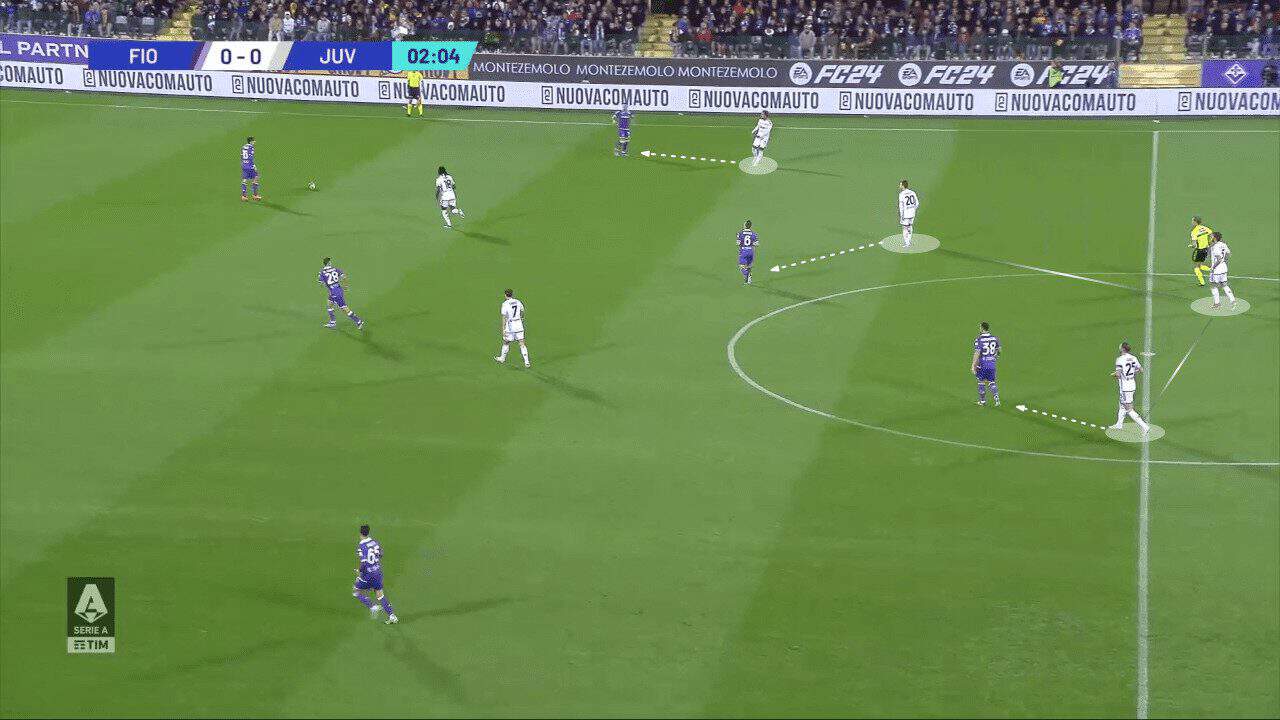
When Arthur dropped on the first line to form a back-three, one of the away side midfielder was dragged to match the 3v2 situation.
Meanwhile, Gonzalez, who started at the left-winger position (shadowed), is joining the midfield to get Locatelli in a 2v1 against him and Rolando Mandragora.
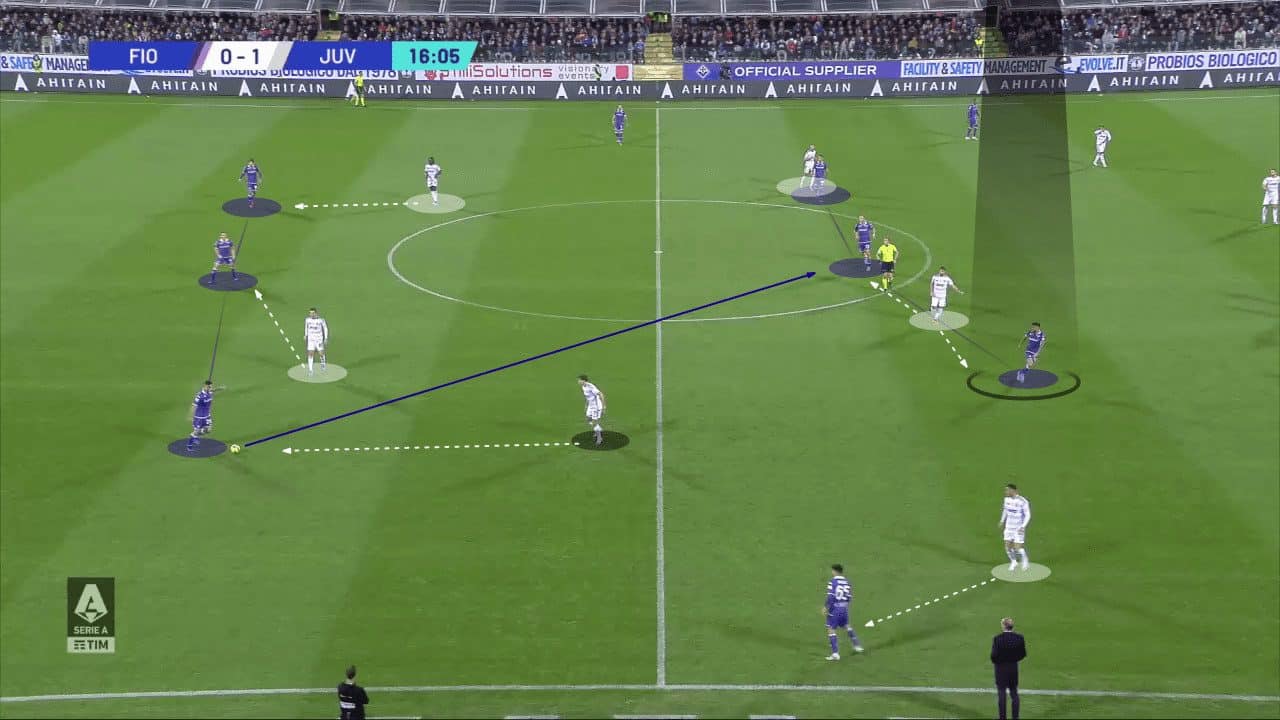
The same idea happened when Parisi was dropping in the first line.
Even so, that did not occur as frequently as possible, and Fiorentina was struggling with that game in possession.
During the Final third attack.
Their impressive flexibility and switching of roles between the players continued at their final third attack phase.
Normally, Arthur would stay in the deep-line playmaker role whether alone or joined by one of the midfield / inverted full-backs.
Here, the shadowed players are Kayode and Parisi, the full-backs positioned on the half-spaces, while the wingers Ikoné and Josip Brekalo provide the width from each side.
Bonaventura, Duncan and Nzola formed a deep central attacking triangle behind the opposition’s midfield line.
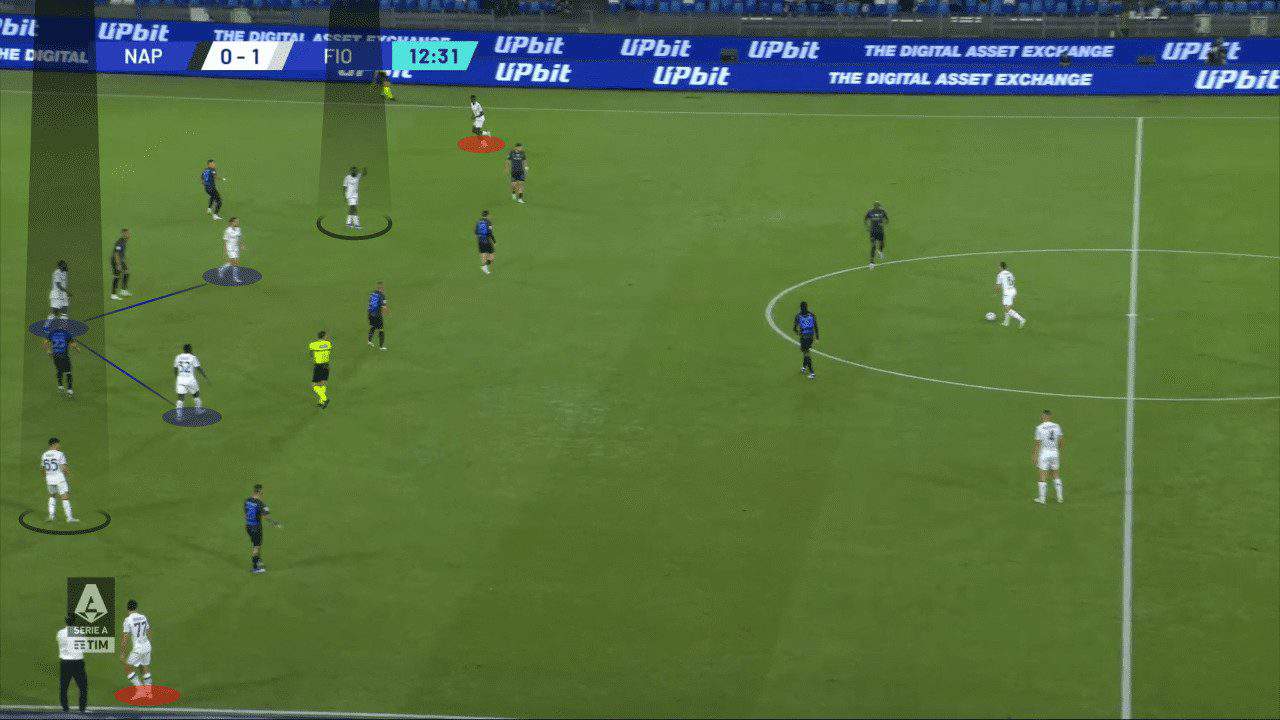
One of Bonaventura or Duncan is overloading one side (usually the left one) to utilise Parisi’s brilliant attacking in underlapping.
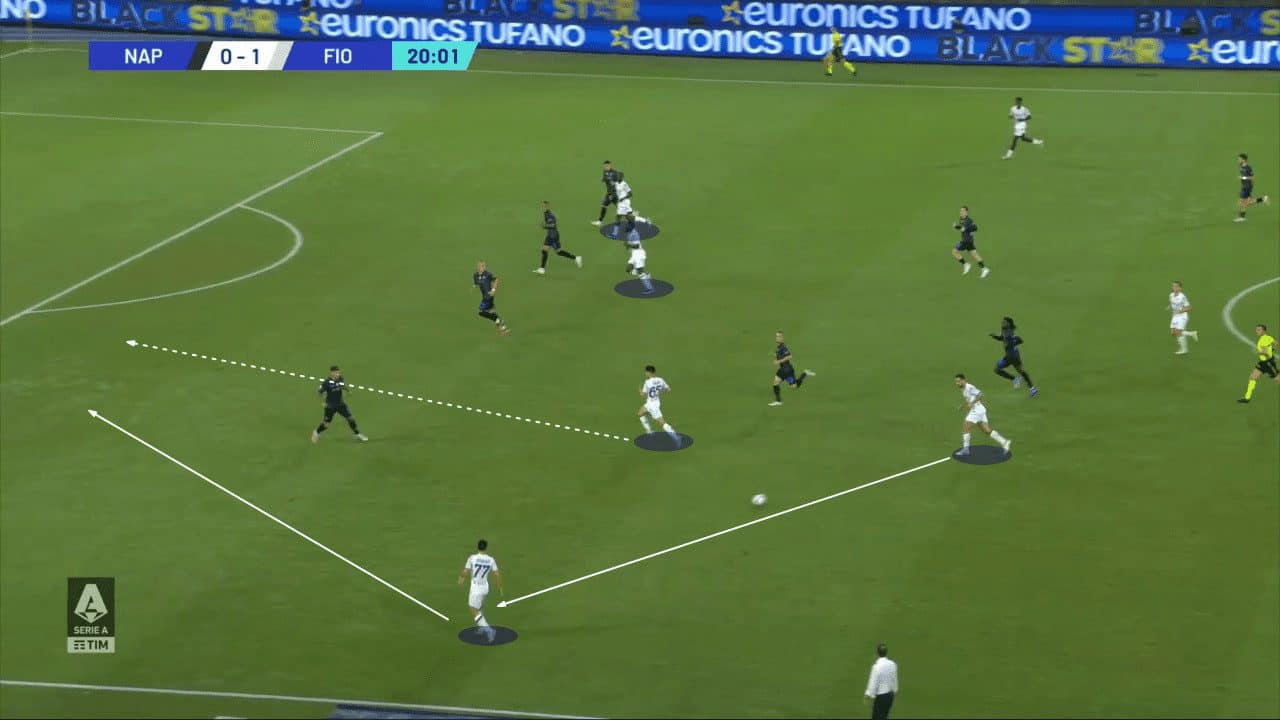
Here, Duncan is dropping with Arthur in the midfield while Bonaventura, Ikoné and Parisi are positioned behind Napoli’s midfield line, and Kayode is positioned as a normal right-back.
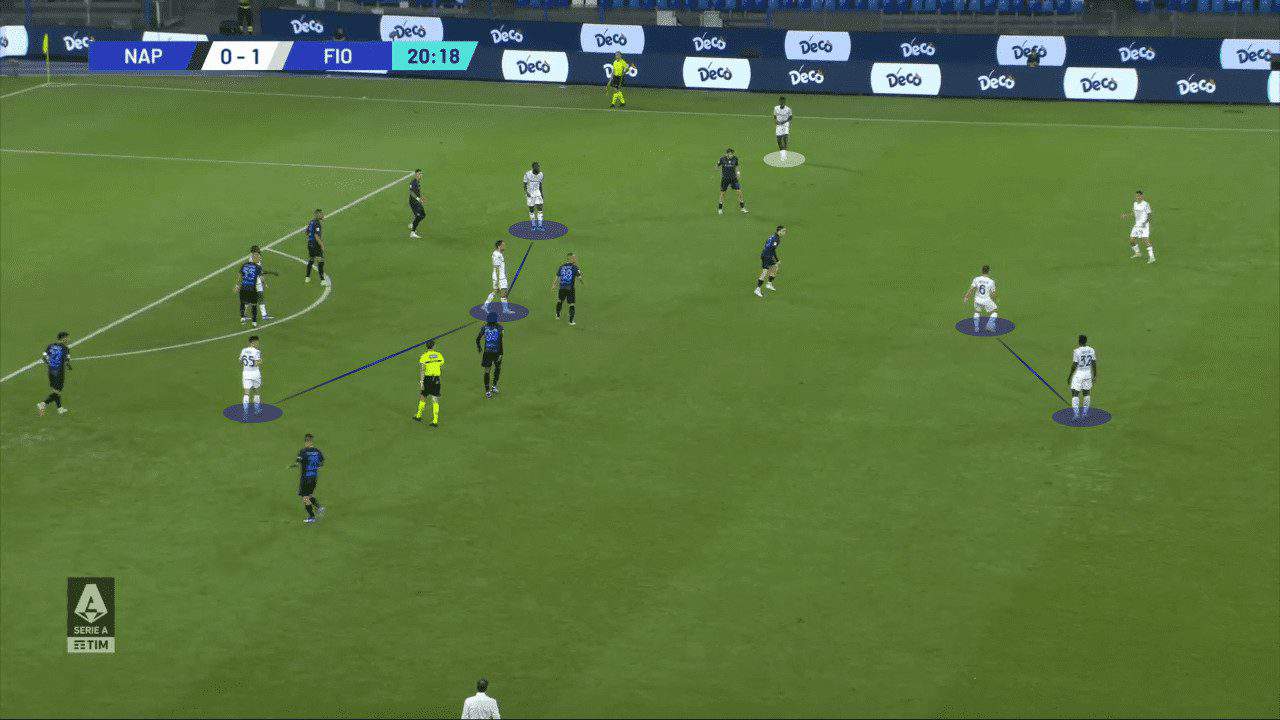
We already discussed Martínez rule during the attacking phases, but we must also mention his clever, unpredictable runs inside the box.
Here, as shown, he completed his run into the box and hit the post.
Most importantly, he dragged Napoli’s De Lorenzo, freeing the space for Brekalo to score the opener.
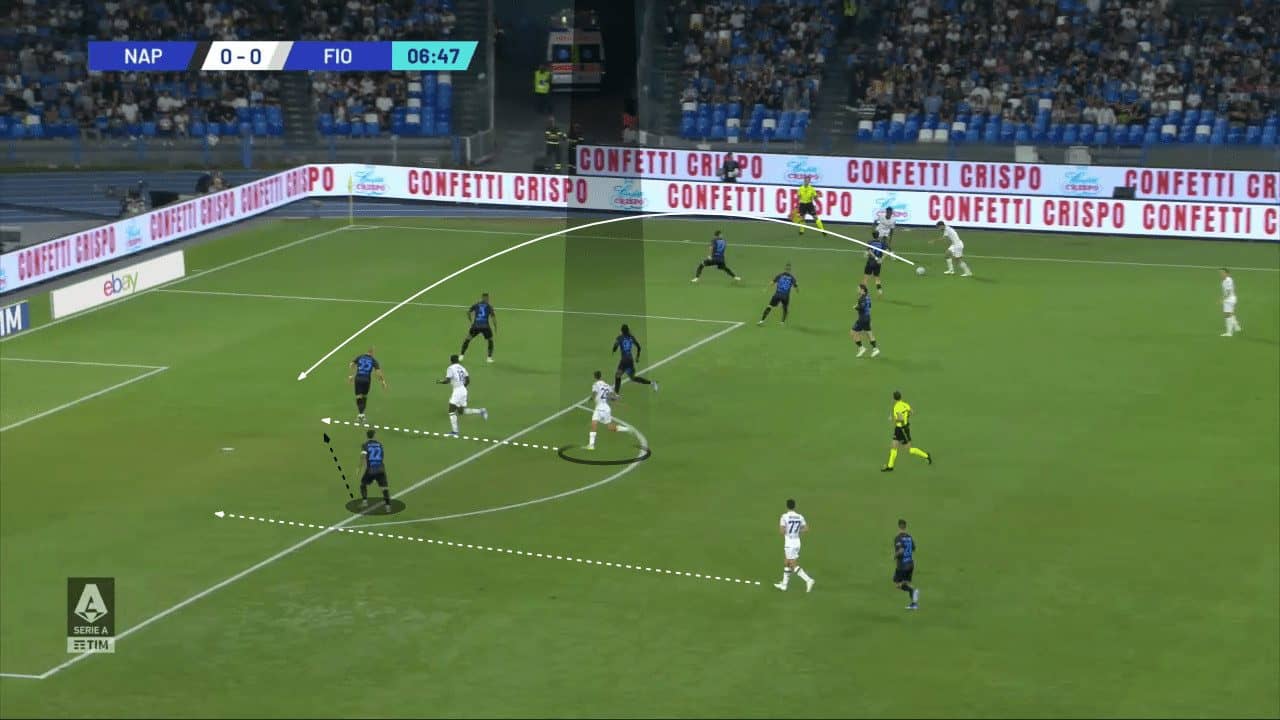
Moving on to Lazio’s game, Parisi maintains a hybrid role between inverting and being widely positioned.
In contrast, Biraghi (shadowed) stayed wide, while Gonzalez was narrow most of the time.
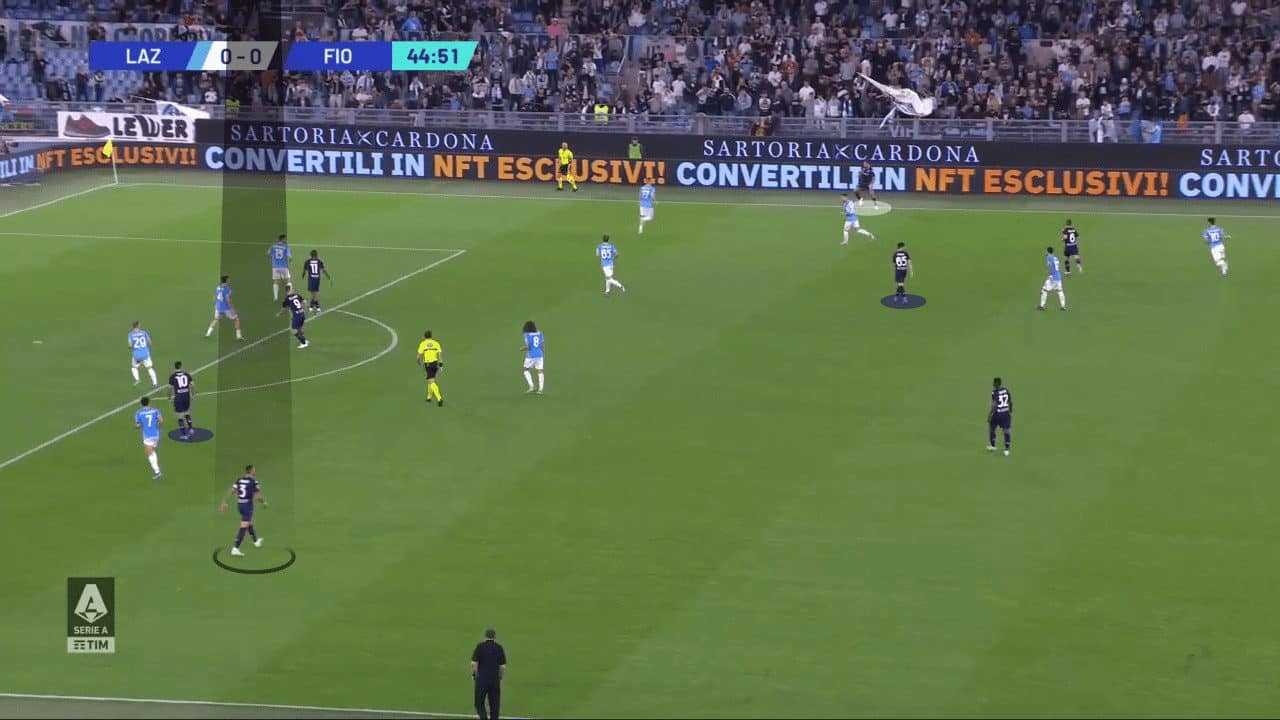
Conclusion.
To sum up, Fiorentina has been one of the best Italian teams offensively so far.
They showed a great variation in their ideas and schemes.
Nevertheless, they suffered against the aggressive high press and rushed to play the long balls, which cost them losing possession, and they still need to improve that.
They have been consistently in the top half of the Serie A standings as well as their astonishing UEFA Europa Conference League and leading their group stage until the moment and still going to improve.





Comments